Stowe House
Stowe House is a grade I listed country house in Stowe, Buckinghamshire, England. It is the home of Stowe School, an independent school and is owned by the Stowe House Preservation Trust who have to date (March 2013) spent more than £25m on the restoration of the house. Stowe House is regularly open to the public. The gardens (known as Stowe Landscape Gardens), a significant example of the English garden style, along with part of the Park, passed into the ownership of The National Trust in 1989 and are open to the public. The parkland surrounding the gardens is open 365 days a year. National Trust members have free access to the gardens but there is a charge for all visitors to the house which goes towards the costs of restoring the building. The gardens and most of the parkland are listed grade I separately from the House.
| Stowe House | |
|---|---|
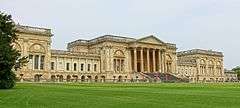 The south front of the house by Robert Adam | |
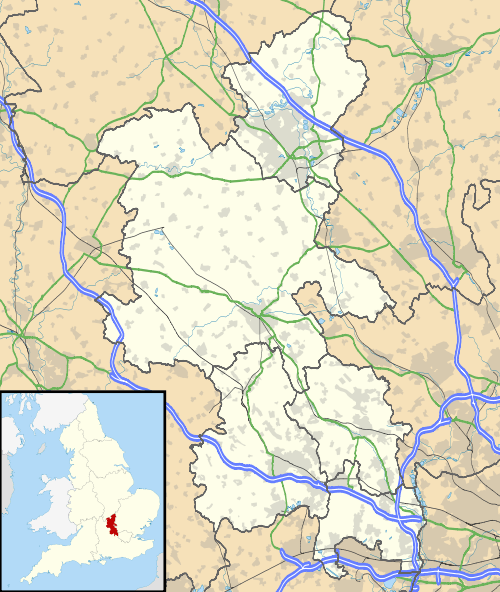 Location within Buckinghamshire | |
| General information | |
| Architectural style | English Baroque Palladian architecture Neoclassical architecture |
| Town or city | Buckingham, Buckinghamshire |
| Country | United Kingdom |
| Coordinates | 52.031963°N 1.017560°W |
| Construction started | 1677–1683 1720–1733 1740–1760 1770–1779 |
| Design and construction | |
| Architect | John Vanbrugh James Gibbs William Kent Giacomo Leoni Giovanni Battista Borra Robert Adam Vincenzo Valdrè John Soane Edward Blore |
Listed Building – Grade I | |
| Official name | Stowe: The Mansion with Attached Service Ranges |
| Designated | 25 September 1951 |
| Reference no. | 1289788[1] |
National Register of Historic Parks and Gardens | |
| Designated | 30 August 1987 |
| Reference no. | 1000198 |
History
.jpg)
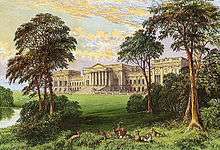
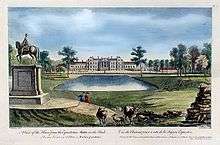
Sir George Gifford MP and Knight, born 1495 died 27 December 1557, owned Stowe Manor and Rectory. He willed it to his son Thomas Gifford, born about 1542 died 16 February 1593. His will was dated 20 November 1556 and proved 19 January 1557/58 and again on 21 November 1562. The Temple family fortune was based on sheep farming, at Witney in Oxfordshire. Later from 1546 they rented a sheep farm in Burton Dassett in Warwickshire. The Stowe estate was leased from Thomas Gifford in 1571 by Peter Temple whose son, John Temple, bought the manor and estate of Stowe in 1589 and it eventually became the home of the Temple family. In the late 17th century, the house was completely rebuilt by Sir Richard Temple, 3rd Baronet, (c.1683) on the present site. This house is now the core of the mansion known today. The old medieval stronghold was located near Stowe Parish Church which is about 100 yards to the south-east of the current house. Having been redesigned subsequently over the years, the whole front is now 916 feet (279 m) in length and can be seen as you approach from the direction of Buckingham. A long, straight driveway ran from Buckingham all the way to the front of the house, passing through a 60-foot (18 m) Corinthian arch on the brow of the hill on the way. The driveway approach to the house is still in use today, although it no longer runs through the arch.
British and foreign aristocrats and royalty frequently stayed at the house throughout the 18th and 19th centuries. In 1725 The 3rd Earl of Carlisle and his wife stayed for a fortnight. The 1730s and 1740s saw visits by Henrietta, Countess of Suffolk, and The 1st Earl of Bath; The Prince Frederick, Prince of Wales, along with other friends of Lord Cobham (see the Temple of Friendship), were also frequent guests. In 1750, The 1st Earl of Bristol attended a reception at the house. In 1754 Count Stanisław August Poniatowski (the future King of Poland) visited the gardens. The 1760s saw two visits by Leopold III, Duke of Anhalt-Dessau, as part of his tours of English gardens in preparation for the creation of the Dessau-Wörlitz Garden Realm. 1768 saw the visit of King Christian VII of Denmark. In July 1770[2] there was a house party lasting several days whose guests included Princess Amelia, The Hon. Horace Walpole, Lady Mary Coke and The 2nd Earl of Bessborough. The Prince Regent (the future King George IV) came in 1805 and 1808. King Louis XVIII came in January 1808 for several days, his party including: the Comte d'Artois, Louis's brother and successor as King of France; the Duc d'Orléans (who would be France's last ever King); and the Prince of Condé.
1810 saw the visit of King Gustav IV Adolf of Sweden. Tsar Alexander I of Russia visited in 1810 and in 1814 Grand Duke Michael of Russia also visited. 1816 saw a visit by Hermann Graf Pückler. The Graf, a famous travel writer from Upper Lusatia, was later elevated in the Prussian peerage as Hermann, Fürst von Pückler-Muskau. Then in 1818 Grand Duke Nicholas (the future Tsar of Russia) visited. The same year saw the first of many visits by The Duke of Clarence (the future King of Great Britain and Ireland). Following King William IV's death, his widow Queen Adelaide stayed in 1840. That year also saw visits by The Duke of Cambridge and his son Prince George. In 1843 there were several visits by German royalty, with the British-born King Ernest Augustus of Hanover and his wife, Frederica of Mecklenburg-Strelitz, staying at the house. Later that year, both Crown Prince Johann of Saxony and Crown Prince Wilhelm of Prussia (later the first German Kaiser) would stay at Stowe. Queen Victoria and Prince Albert stayed at the house for several days in 1845. Due to financial problems, the family let the estate to the Comte de Paris from 1889 to 1894. The Comte died that year in the house; his body was laid in state in the Marble Saloon, during which period The Prince Albert Edward, Prince of Wales (the future King Edward VII), paid his respects.
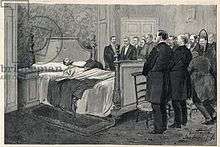
Famous non-royal visitors included: Alexander Pope, a frequent visitor from 1724 onwards, who, in 1726, visited in the company of Dean Jonathan Swift and John Gay; another writer and friend to Lord Cobham who visited in the 1720s was William Congreve; in 1730 James Thomson wrote the poem The Seasons after visiting the gardens; in 1732 Gilbert West a nephew of Lord Cobham's, wrote his poem Stowe after visiting the gardens; 1750 saw the first of eight visits by Sanderson Miller; the 1750s also saw visits by Jean-Jacques Rousseau; in 1770 Thomas Whately wrote an extensive description of the gardens; François-Joseph Bélanger visited in 1777–1778 and drew the gardens. In April 1786 John Adams (the future second President of the United States on tour with Thomas Jefferson—who would serve as his vice president before becoming President himself) visited Stowe and other notable houses in the area, after visiting them he wrote in his diary "Stowe, Hagley, and Blenheim, are superb; Woburn, Caversham, and the Leasowes are beautiful. Wotton is both great and elegant, though neglected".[3] However, in his diary he was also damning about the means used to finance the large estates, and he did not think that the embellishments to the landscape, made by the owners of the great country houses, would suit the more rugged American countryside.[3] William Crotch visited in 1805, as did Charles James Fox in the party that included the Prince Regent.
The Temple-Grenville family
The propensity to marry heiresses is shown by the family name being changed to Temple-Nugent-Brydges-Chandos-Grenville by the late 18th-century. The following family members were the owners of the estate and creators of the house & gardens as they now exist:
- Peter Temple, ?-1578: leased the estate in 1571.
- John Temple, 1542–1603: first inherits the lease from his father Peter then purchased the estate in 1589.
- Sir Thomas Temple, 1567 – c. 1637: 1st Baronet, he inherited from his father John.
- Sir Peter Temple, 1592–1653: 2nd Baronet, he was given the estate by his father the 1st Baronet in 1630. He kept the house but became a bankrupt.
- Sir Richard Temple, 1634–1697: 3rd Baronet, he inherited the estate from his father, the 2nd Baronet.
- Richard Temple, 1st Viscount Cobham, 1675–1749: 4th Baronet, later Baron Cobham and finally Viscount Cobham, he inherited from his father, the 3rd Baronet.
- Richard Grenville-Temple, 1711–1779: 2nd Earl Temple, he inherited from his uncle, Viscount Cobham.
- George Nugent-Temple-Grenville, 1753–1813: 1st Marquess of Buckingham, he inherited from his uncle, the 2nd Earl Temple.
- Richard Temple-Nugent-Brydges-Chandos-Grenville, 1776–1839: 2nd Marquess of Buckingham later 1st Duke of Buckingham & Chandos, he inherited from his father, the 1st Marquess of Buckingham.
- Richard Plantagenet Temple-Nugent-Brydges-Chandos-Grenville, 1797–1861: 2nd Duke of Buckingham & Chandos, he inherited from his father, the 1st Duke.
- Richard Plantagenet Campbell Temple-Nugent-Brydges-Chandos-Grenville, 1823–1889: 3rd Duke of Buckingham & Chandos, he inherited from his father, the 2nd Duke.
- Lady Mary Morgan-Grenville, 1852–1944: 11th Lady Kinloss, she inherited from her father, the 3rd Duke.
- Richard G. Morgan-Grenville, 1887–1914: was given the estate in 1908 by his mother Lady Kinloss. He was killed fighting in the Great War, at Ploegsteert Wood.
- Reverend Luis C.F.T. Morgan-Grenville, 1889–1944: inherited the estate on the death of his brother Richard, and sold it in 1921.
Gallery of the main creators of Stowe
 Viscount Cobham, owned Stowe 1697-1749
Viscount Cobham, owned Stowe 1697-1749 2nd Earl Temple, owned Stowe 1749-1779
2nd Earl Temple, owned Stowe 1749-1779 1st Marquess of Buckingham, owned Stowe 1779-1813
1st Marquess of Buckingham, owned Stowe 1779-1813
John Temple was the first member of the family to serve as High Sheriff of Buckinghamshire and also Justice of the Peace.
Sir Thomas Temple first purchased a knighthood in 1603 from James I then purchased from the same monarch the baronetcy in 1611. He was the first member of the family to serve as a member of parliament in 1588–1589.
Sir Peter Temple was a supporter of Oliver Cromwell and served as a colonel in the parliamentary army during the English Civil War.
When the War of the Spanish Succession broke out in 1702 the 4th Baronet was appointed a colonel by William III, he was later promoted to Lieutenant General. First created Baron Cobham in 1714 by King George I, then in 1718 Viscount Cobham by the same king. In 1715 he married Anne Halsey an heiress of a rich London brewer. She brought a dowry of £20,000 (equivalent to £3,150,000 as of 2019).[4][5] He was a member of the Kit-Cat Club where he probably first met fellow members John Vanbrugh and Joseph Addison whose writings on garden design influenced the development of the gardens at Stowe. Cobham was the centre of the Whig party grouping of Cobhamites. His sister Hester was created Countess of Temple in her own right in 1749 by King George II, from which her son, heir to the estate inherited his title as 2nd Earl Temple.
Richard Grenville the future 2nd Earl Temple, married Anna Chamber in 1737, an heiress with a £50,000 fortune.[6] He was leader of the Whig group known as the Grenvillites. King George II made Earl Temple a Knight of the Garter in 1760. Earl Temple was an active supporter of John Wilkes. When the Earl's cousin George Dodington, 1st Baron Melcombe died in 1762 he left his Vanbrugh designed house Eastbury Park and estates in Dorset to Earl Temple. He attempted to sell the house, but as no buyer could be found, he demolished most of the building using the marble from the house in the Marble Saloon at Stowe. The Eastbury estate was finally sold in 1806.
The 2nd Earl Temple's sister Hester married William Pitt the Elder who became Prime Minister of Great Britain. Their son William Pitt the Younger also served as Prime Minister. George Grenville the brother of the 2nd Earl Temple was also to serve as Prime Minister. William Grenville youngest brother of the 1st Marquess of Buckingham also served as Prime Minister, and it was during his premiership that the Atlantic slave trade was abolished. The final family member to be Prime Minister was William Ewart Gladstone. He married Catherine Glynne the granddaughter of Catherine sister of the 1st Marquess of Buckingham. Other notable politicians in the family included Thomas Grenville the brother of the 1st Marquess, Robert Nugent, 1st Earl Nugent the father-in-law of the 1st Marquess, Thomas Pitt, 1st Baron Camelford brother of William Pitt the elder, George Nugent-Grenville, 2nd Baron Nugent brother of the 1st Duke and the 1st Marquess's nephew Richard Griffin, 3rd Baron Braybrooke. The Foreign Secretary (from 1938 to 1940) Lord Halifax was also related to the family, through his mother Lady Agnes Elizabeth Courtenay, daughter of Lady Elizabeth Fortescue, herself daughter of Hester Grenville, daughter of George Grenville, the Prime Minister.
George Nugent-Temple-Grenville undertook the grand tour in 1774. In 1775 he married a Catholic heiress Mary Nugent, who had an income of £14,000 a year.[6] He was created 1st Marquess of Buckingham in 1784 by King George III. On the death in 1788 of the Marquess's father-in-law Robert Nugent, 1st Earl Nugent he inherited the Earl's Irish (8,900 acres (3,600 ha)) and Cornish estates.
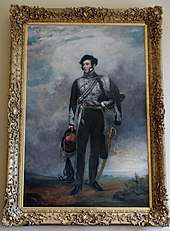
The 2nd Marquess of Buckingham married in 1796 Anna Eliza Brydges the daughter and heiress of James Brydges, 3rd Duke of Chandos who had died in 1789.[7] He thus acquired this wife's estates in Hampshire and Middlesex. Up until 1822 the family had been staunch Whigs, but in order to obtain the long sought Dukedom the family became Tories. The Dukedom was bestowed in 1822 by King George IV on Richard Temple-Nugent-Brydges-Chandos-Grenville 2nd Marquess who became the 1st Duke of Buckingham and Chandos. The deal was to support the then Prime Minister Lord Liverpool's administration. The family spent a great deal of money to control several rotten boroughs, including Old Sarum, whose M.P.s switch their support to the prime minister, although the 1832 Reform Act would end this practice. The 1st Duke was a Colonel in the Royal Buckinghamshire Militia (King's Own), he led his battalion in 1814 to France under the command of The Duke of Wellington.
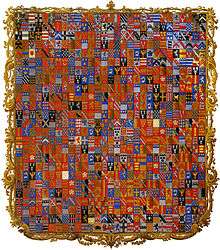
The 2nd Duke through his mother Anna was descended from the House of Plantagenet and was an active member of the Royal Buckinghamshire Yeomanry. His support of which added to the debts of £1,464,959 (well over £100,000,000 in 2003 terms) he had accrued by 1845. He was called the Greatest Debtor in the world.[8] The Duke left to live abroad in August 1847 to escape his creditors. That year saw the sale of the family's London home Buckingham House[9] in Pall Mall. In March 1848 the family estates in Ireland, Hampshire, Gloucestershire, Somerset, Cornwall, Oxfordshire, Northamptonshire & Middlesex some 36,000 acres (15,000 ha) of land, were sold. Followed by the most valuable of the paintings, furniture, the Household silver was sold in 836 lots over a week in September, and other art works at Stowe, the over 21,000 bottles of wine and over 500 of spirits in the wine cellars below the Marble Saloon, were all sold from 15 August to 7 October 1848 by Christie's. The auction was held in The State Dining Room, but only raised £75,400.[10] At the end of the sales the estate had contract to the core 10,000 acres (4,000 ha) in Buckinghamshire. The garden staff were cut from 40 to 4. In January 1849 there was a 24-day sale at Sotheby's of the books from the library, that raised £10,356.
Richard Plantagenet Campbell Temple-Nugent-Brydges-Chandos-Grenville, 3rd Duke of Buckingham and Chandos (10 September 1823 – 26 March 1889), usually shortened to Richard Temple-Grenville, was a British statesman of the 19th century, and a close friend and subordinate of Benjamin Disraeli. He was styled Marquess of Chandos until the death of his father in 1861.
With the death of the third Duke of Buckingham and Chandos in 1889, there remained no heirs-male to the dukedom, so it became extinct. After which ownership of the estate was separated from the title Earls Temple of Stowe which passed by special remainder in the letters patent, creating it through the female line to a nephew of the 3rd Duke William Temple-Gore-Langton, the son of Lady Anna Eliza Mary Grenville sister of the 3rd Duke. The fall of the family engendered Lord Rosebery's comment "The glories of the House, built up with so much care and persistence, vanished like a snow wreath".
After the death of her father the 3rd Duke, Lady Mary Morgan-Grenville tried to sell house and estate for £200,000, but nobody wished to buy it. It was then rented until 1894 after which the house remained unoccupied until 1901 when Lady Mary returned as a widow, her husband Major Luis Morgan-Grenville having died in 1896 and she lived in the house until 1908 when she passed it onto her unmarried son as he came of age at 21.
The last inheritor of the estate, Rev. Luis C.F.T. Morgan-Grenville, due to prodigious debts, sold the house, gardens and part of the park in 1921 to a Mr Harry Shaw for £50,000[11] who intended to present the house to the nation. But being unable to pay for an endowment to maintain the building it was sold again in 1922 to the governors of what became Stowe School. This opened on 11 May 1923. The rest of the estate was sold as separate lots. Clough Williams-Ellis purchased the Grand Avenue to prevent its felling to create building plots. Later he gave it to the school. The gardens remained in the ownership of the School until 1989 when an anonymous donor provided funds for an endowment and the National Trust assumed ownership. In 1997 the ownership of the house passed to the Stowe House Preservation Trust, the major aim of which is to restore the building.
House
Architectural history
The house is the result of four main periods of development[12] these are:
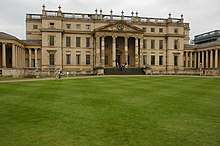

- 1677–1683 under Sir Richard Temple. This involved the building of the central block. The architect was William Cleare who worked for Sir Christopher Wren as his chief joiner. The house was of brick four floors high including the basement and attics and thirteen bays in length.
- 1720s–1733 under Viscount Cobham, including the addition of the Ionic North tetrastyle Portico by Vanbrugh and the rebuilding of the north, east and west fronts. After Vanbrugh's death in 1726 work continued under William Kent it was probably he who designed the now demolished two-tier south portico that consisted of four Tuscan columns with four Ionic or Composite columns above.
- 1740s–1760 under Viscount Cobham, the expansion of both the western and eastern state apartments.
- 1770–1779 under Earl Temple having first obtained a design from Jacques-François Blondel for the new south front of the house, which did not meet with the Earl's approval, in 1771 Robert Adam produced a new design for the south front; this design was adapted and made more uniform by Thomas Pitt assisted by Giovanni Battista Borra and was finished in 1779. The interiors of the new state apartments were not completed until 1788, much of the interior work being by an Italian, Vincenzo Valdrè (1740–1814). At the same time, the final remodelling of the North Front was taking place: this involved the erection in 1770–1772 of the two twin quadrant colonnades of Ionic columns that flank the facade. These may be to Robert Adam's design. The northern ends of the colonnades are linked to screen-walls containing gateways by William Kent which were moved from the forecourt to this position and heightened in 1775 by Vincenzo Valdrè. The east gateway leads to the stable court the west to the kitchen court. At right angles to these walls stand the arches designed by Giacomo Leoni c. 1740; these were formal entrances to the gardens, they now lead to various buildings put up by the school.
The exterior of the house has not been significantly changed since 1779, although in the first decade of the 19th century, the Egyptian Hall was added beneath the North Portico as a secondary entrance.
Stowe Library
In 1793 George, 1st Marquess of Buckingham, converted The East Gallery into The Large Library and, in the first decade of the 19th century, on the ground floor created the Gothic Library to the designs of Sir John Soane. This is a rare example of Soane using the Gothic style.
The 1st Duke inherited the library of Lord Grenville, his uncle, described in 1824 as
- in history, philosophy, political economy, mathematics, diplomatic state papers, both printed and manuscript, is the most perfect collection in this country.[13]
Following the bankruptcy of the 2nd Duke, much of the valuable collection was sold. The library has provided provenance to many valued manuscripts[14] including the Stowe 2 Psalter, Stowe 54, the Stowe Breviary and the "Stowe manuscripts".
Gallery of architects, garden designers and artists who worked at Stowe
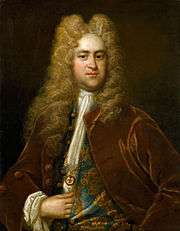 Sir John Vanbrugh, 1664-1726 (architect, worked at Stowe c.1720 to 1726)
Sir John Vanbrugh, 1664-1726 (architect, worked at Stowe c.1720 to 1726) James Gibbs, 1682-1754 (architect, worked at Stowe 1726 to 1749)
James Gibbs, 1682-1754 (architect, worked at Stowe 1726 to 1749)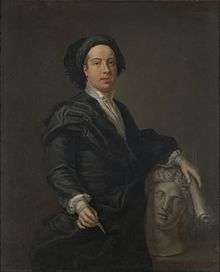 William Kent, 1685-1748 (architect, painter and garden designer, worked at Stowe 1731 to 1748)
William Kent, 1685-1748 (architect, painter and garden designer, worked at Stowe 1731 to 1748) Charles Bridgeman, 1690-1738, (garden designer, worked at Stowe 1711 to 1733)
Charles Bridgeman, 1690-1738, (garden designer, worked at Stowe 1711 to 1733)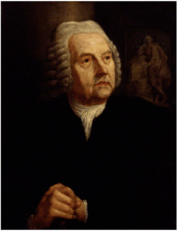 Peter Scheemakers, 1691-1781 (sculptor, carved the statues in the Temple of Ancient Virtue, The pediment on the Temple of Concord & Victory and eight of the British Worthies)
Peter Scheemakers, 1691-1781 (sculptor, carved the statues in the Temple of Ancient Virtue, The pediment on the Temple of Concord & Victory and eight of the British Worthies) John Michael Rysbrack, 1694-1770, (sculptor, carved the Saxon deities and eight of the British Worthies)
John Michael Rysbrack, 1694-1770, (sculptor, carved the Saxon deities and eight of the British Worthies)_Brown_by_Nathaniel_Dance%2C_(later_Sir_Nathaniel_Dance-Holland%2C_Bt)_cropped.jpg) Lancelot 'Capability' Brown, 1716-1783 (garden designer, worked at Stowe 1741 to 1751)
Lancelot 'Capability' Brown, 1716-1783 (garden designer, worked at Stowe 1741 to 1751)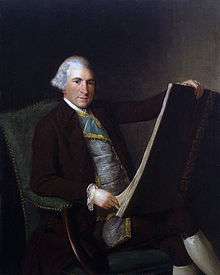 Robert Adam, 1728-1792 (architect, worked at Stowe 1770 to 1771 Adam's design for the south front was modified in execution by Thomas Pitt and completed in 1779)
Robert Adam, 1728-1792 (architect, worked at Stowe 1770 to 1771 Adam's design for the south front was modified in execution by Thomas Pitt and completed in 1779)- Sir John Soane, 1753-1837 (architect, worked at Stowe 1805 to 1807)
The south facade


.jpg)
The showpiece of the House is the south facade overlooking the gardens. This is one of the finest examples of neoclassical architecture in Britain. The main front stretches over 460 feet (140 m). Divided into five major sections, these are: the central block around 130 feet (40 m) in width, the lower linking sections 75 feet (23 m) wide that contain on the west the State Dining Room and on the east The Large Library, then at the ends the two pavilions the same height as the central block about 90 feet (27 m) in width. The central block and the end pavilions are articulated at piano nobile level with unfluted Corinthian pilasters over 35 feet (11 m) tall which becomes a hexastyle portico supporting a pediment in the middle of the facade, there is a minor order of 48 Ionic columns over 20 feet (6.1 m) high that runs the length of the facade. The portico fronts a loggia that contains the doorway to the Marble Saloon, this is flanked by large niches that used to contain ancient Roman statues, between the columns of the portico used to be the marble sculpture of Vertumnus and Pomona by Laurent Delvaux now in the V&A. Above the niches is a large frieze on a Bacchic theme, this is based on an engraving in James Stuart's and Nicholas Revett's Antiquities of Athens of the frieze on the Choragic Monument of Lysicrates.
There is a flight of thirty three steps the full width of the portico which descends to the South Lawn. The staircase has solid parapets either side that end in sculptures of Medici lions standing and resting a paw on a ball. These are the original lions dating from the late 1700s. They were sold in 1921 to Blackpool Corporation and had been standing in Stanley Park in Blackpool but were reinstated in 2013 in a swap deal that saw copies going to Blackpool. Either side of the portico are two tripartite windows separated and flanked by Ionic columns. These are enclosed with an arch that contains a carved Portland stone tondo in the tympanum with carvings of The four seasons, and is in turn flanked by twin Corinthian pilasters the same size as the columns of the portico. The facade is surmounted by a balustraded parapet, in the centre of the parapet of the east pavilion is a sculpture of two reclining figures of Ceres and Flora the corresponding figures on the west pavilion are of Liberty and Religion. The end pavilions each have three tripartite windows matching those on the central block, the tondos of which are each carved with a sacrificial scene.
The ground floor is lower than the floor above, about 15 feet (4.6 m) in height and visually acts as a base to the facade, it is of banded rustication with simple arched windows beneath each window on the upper floor. In 1790 a balustrade was added parallel to the façade that ran from the bottom of the steps the full length of the house and then returned at both ends, there are a series of 30 pedestals along the balustrade, that until their sale in 1921 were topped by bronze urns. These were replaced by replicas in 2013. This was probably added to keep visitors from the lower windows of the house, and formal flower beds were laid out in the area.
The major interiors
During the sales of 1921 & 1922 all the remaining furnishing and art works not sold in 1848 were auctioned, as were several fittings including chimneypieces. Some of the family portraits and other items associated with the house have been bought back and are now on display in the House. Several owners of Stowe undertook the Grand Tour, Earl Temple spent 1729–1733 in France, Switzerland & Italy, the 1st Marquess in 1774 visited Italy, the 2nd Duke before he inherited his title in 1817, and the 1st Duke in 1827–1829 toured the Mediterranean aboard his yacht the Anna Eliza named after his wife. Many of the art works that adorned the house were acquired both during these trips and through the 1st Duke inheriting his father-in-law's art collection. The 1st Duke, before he inherited Stowe, also bought paintings at the sale of the Orleans Collection in 1798 and continued to buy paintings for another twenty years as well as books, engravings and the Stowe Service of Worcester Porcelain, as well as archaeological specimens. The main rooms are mainly located on the 1st floor (referred to in the US as the 2nd floor) Piano nobile, a few are on the ground floor (referred to in the US as the 1st floor).
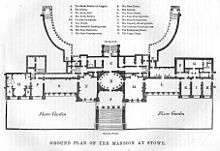
The major rooms are:
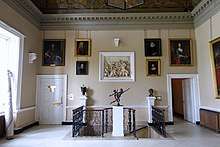
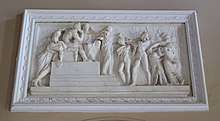
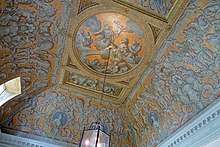
- The North Hall[15]
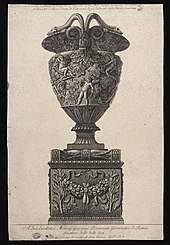
located behind the north portico this is the main Entrance Hall of the house and the least changed of the rooms dating from the 1730s. The ceiling has a deep cove, and was painted by William Kent in grisaille on gold background imitating mosaic. There are six classical deities depicted in the cove, Mercury, Jupiter, Venus, Saturn, Apollo and Diana. There are also nine of the signs of the zodiac. The flat centre of the ceiling is enclosed in a plaster beam, which in turn encloses a square with a circle within which encloses a painting of Mars. The south wall has in its centre a large set of doors which lead into The Marble Saloon, either side of these doors are portraits by Sir William Beechey of on left Richard, first Duke of Buckingham & Chandos on the right Anna Eliza, First Duchess of Buckingham & Chandos she is depicted with her son later the 2nd Duke. The west wall has above the fireplace Thomas Banks's white marble relief of Caractacus before the Emperor Claudius in its centre which is flanked by two doors. The east wall has above a small staircase leading to the ground floor, Christophe Veyrier's white marble relief of The family of Darius before Alexander the Great in its centre flanked by two doors. Works of art sold in 1848 that used to be in this room include Anthony van Dyck's portrait of the Marquess of Vienville, and among other sculpture two marble vases bought as Ancient Roman but actually the work of Giovanni Battista Piranesi, one of these is now in the Los Angeles County Museum of Art.
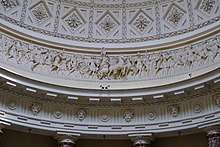

- The Marble Saloon[16] is the grandest interior in the House, located immediately behind the south portico. Based on the Pantheon. It is elliptical in plan, 63 by 45 feet (19 by 14 m), the domed ceiling is over 56 feet (17 m) high. The room was probably designed by Vincenzo Valdrè, the basic structure was built between 1775 and 1777 but decoration was probably only complete by 1788 at a cost of £12,000. The lower half of the walls are surrounded by 16 unfluted Roman Doric columns made from red scagliola with white veins that mimics Sicilian Jasper the work of Domenico Bartoli and with white marble capitals and bases, supporting a richly detailed Doric entablature of white plaster with satyrs on the metopes. Hanging from the soffit of the entablature between each pair of columns are replica brass lanterns with glass domes, these are copies of the original light fittings. These columns flank four doors on the cardinal directions, the rest flank plain niches that once contained eight Ancient Roman statues these were sold in 1848, new plaster casts of eight statues from the Berlin State Museums were added to the niches flanking each door and were unveiled in September 2009. Added at the same time to the niches between each pair of statues were fibreglass copies of the original gilded Athéniennes (or Torchieres), the originals were made of timber and painted and gilded to resemble metal. Above the niches and doorways are white plaster rectangular reliefs depicting arms and trophies. Above the entablature is the very elaborate frieze, this consists of over 280 human and 14 animals in plaster all alto-relievo, the sculptor was probably Charles Peart. The subject of the frieze is the suovetaurilia. The dome is coffered of white plaster, there are 160 coffers nearly all of unique shape. The coffers contain highly decorated rosettes, and the ribs in between are also very elaborately decorated. There is a central skylight also elliptical. The floor is made of 72 four-foot-square slabs of white Carrara marble resting on a brick vault, in the centre of the floor is a metal grill part of the heating system. This is the first room to be fully restored to its pre-1848 condition.
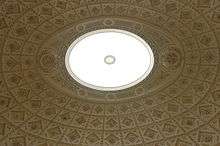
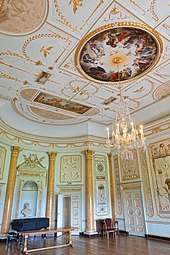
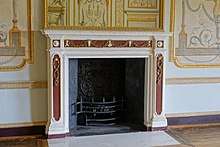
- The State Music Room[17] to the east of The Marble Saloon is about 30 by 40 feet (12 m), probably designed by Valdrè and finished in the early 1780s. With an apse in the centre of the north wall, there are doors at each end of the side walls, though only the northern pair are real, the other two are false doors. The north has within the apse two sets of doors flanking a niche that is surrounded by a decorative frame. There are two un-fluted scagliola Corinthian columns on the corners of the apse and also within it flanking the niche. The walls are painted with panels in the form of Grotesques and Arabesques. The chimneypiece in the centre of the east wall of white marble inset with panels of rosso antico marble and with carved decoration of musical instruments in white marble and ormolu, this chimneypiece was sold in 1922 but bought back in 1991, and a new mirror above the chimneypiece was made to replace the original one. The plaster ceiling has gilt molded decoration and seven inset paintings. The central painting is circular and is of The Dance of the Hours after Guido Reni and is flanked to the north and south by two rectangular paintings of the four seasons. Between these large paintings are four smaller ones of landscape scenes. All the paintings are believed to be by Valdrè. The central chandelier is a recreation of 2012 of the one sold in 1848. The ancient Roman sculpture the Marine Venus, that used to stand in the niche, was purchased by Queen Victoria at the 1848 sale and is now at Osborne House. This has been replaced in the niche by a bust of William Pitt the elder by Joseph Wilton, which is on loan to the house. There is mention of a chamber organ in the room in 1779. Also sold in 1848 were two Italian neo-classical side tables with Verd antique tops the frames being carved with plaques of Leda and the Swan and Juno and her peacock, these are both now in the Wallace Collection.
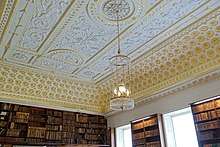
- The Large Library,[18] one of the three libraries in the house, is 75 by 25 feet (22.9 by 7.6 m), it is located to the east of The State Music Room. This room was created in 1793 from the former East Gallery. The plaster ceiling dates from then, with its elaborate cornice supporting a deep coffered cove in each corner of which are clusters of grapes, the flat centre of the ceiling has elaborate decoration, including in the border of the central panel mermen holding and feeding a griffin. The main entrance is in the centre of the long north wall. There are chimneypieces in the centre of each end wall. These are of white marble with flanking caryatids, the jambs are of black marble, one dates from 1792 which is a copy of the other probably dating from the 1760s. Above each chimneypiece is a mirror. The bookcases are of mahogany there are over five hundred shelves on the lower walls and they have their original doors with brass wire grilles. The walls are completely covered by the shelving, and even the walls between the seven windows of the south wall. The upper two hundred and forty shelves are accessed via a gallery running around the east, north and west walls. The over 20,000 volumes that were on these shelves, largely collected by the 1st Marquess of Buckingham were sold in January 1849, at Sotheby's, the sale lasted 24 days. There is a series of three marble busts in the windows that were sold from the house in 1921 but have been repurchased. These are: 1st Duke of Buckingham and Chandos by Raimondo Trentanova, Frederick III, German Emperor and Victoria, Princess Royal both carved by Tito Angelini. Also there are small busts above the bookcases on the window wall, Homer, Francis Bacon, Isaac Newton, Horace, Demosthenes and another of Homer. These were sold in 1921 but donated to the House and returned to their original positions.

- The State Drawing Room[19] also called The Temple Room. Is to the west of The Marble Saloon is about 30 by 40 feet (12 m), with an apse in the centre of the north wall, there are doors at each end of the side walls, though only the northern pair are real, and the other two are false doors. The plaster ceiling is probably a design of Valdrè. Decorated in neo-classical style with a symmetrical arrangement of nereids, tazzas, paterae and other motifs, originally the details were gilt but this was replaced by silver in 1965 restoration. The ceiling dates from 1776 and was executed by James Lovell. The original marble fireplace dated 1777 was sold in 1922 and is now in Spain at the headquarters of Grupo Santander, it contains an antique alabaster bas-relief from Egypt of a Sacrifice to Bacchus. The north wall has an engaged fluted Corinthian columns of wood flanking the apse and a further two within it. There are quarter columns in the corners of the room. The walls used to be hung with red Damask and the finest paintings in the collection hung on the walls. There were in 1838 fifty two paintings hanging on the walls, including: Helena Fourment by Rubens. She was his second wife, now in the Barber Institute; The Exposition of Moses by Nicholas Poussin now in the Ashmolean Museum; The Finding of Moses by Salvator Rosa now in The Detroit Institute of Arts; Assumption of the Virgin by Murillo now in the Wallace Collection; Philip Baptising the Eunuch by Albert Cuyp now at Anglesey Abbey; View of a Village by David Teniers the Younger now in the National Gallery and The Persian Sybil by Domenichino now in the Wallace Collection; several of these works were acquired at the sale of the Orleans Collection. Also the finest pieces of Sèvres porcelain of the over 200 in the collection used to be displayed in this room, but these were sold in 1848. The furnishings included several pieces from the Doge's Palace which are now in other British collections. They include a hexagonal side table, the top inlaid with various marbles in the Wallace Collection, two gilt gesso side tables. One is in the V&A the other at Sudeley Castle.

- The State Dining Room[20] is 75 by 25 feet (22.9 by 7.6 m). Located to the west of The State Drawing Room, created in the 1740s the probable architect being either Henry Flitcroft or 'Capability' Brown. The Stowe House Preservation Trust are currently fundraising to restore this room to its former magnificence. This was The State Gallery until 1817 when it assumed its current name. The ceiling has an elaborate plaster entablature supporting a deep cove, this has painted decoration dated 1747 by Francesco Sleter, including Hebe feeding Jupiter's Eagle east, Cupid playing with two Graces north, Cupid asleep with two Graces south and Diana and her Hounds west, the spaces between these paintings are decorated with animals including swans and their cygnets, pigeons and rabbits. There are three large octagonal paintings on the central flat of the ceiling. These are probably early 19th-century replacements for the original by Robert Jones. They are Venus disarming Cupid east, Venus on her Chariot, crowned by Cupid and attended by the Three Graces centre and Venus at her Toilet, attended by the Graces west. There are also eight smaller octagonal panels depicting pairs of vases and classical reliefs. The areas between these paintings are decorated with painted acanthus and all the paintings are bordered by white and gilt plaster beams decorated in guilloché. The two chimneypieces on the north wall date from the 1920s the original pair were sold in 1922 and are now at Benham Park, these were of white and yellow Siena marbles, with elaborately carved wooded overmantels that contained paintings now in America, these are Goddess conducting Learning east and Mercury conducting Tragedy and Comedy to Parnassus. There are four paintings above the two doors in the west and east walls of male and female centaurs with Bacchic emblems and lyres, probably painted by Robert Jones. The walls used to be hung with five Brussels tapestries commissioned by Viscount Cobham from O. Leyneir, they depict the triumph of classical deities: Ceres, Bacchus, Neptune, Mars and Diana, sold in 1921 they are now in Switzerland. The dining table when fully extended was 65 feet (20 m) long. The walls are hung with various portraits of people associated with the house and family that have been acquired over the years, these are, on the east wall Caroline Harvey wife of the 3rd Duke by Sir Francis Grant, donated by the granddaughter of the sitter, The Hon. Mrs. Thomas Close-Smith (1886–1972) on her death in 1972; above the eastern fireplace Queen Caroline of Ansbach from the studio of Sir Godfrey Kneller; in the centre of the north wall Lady Christian Lyttelton the sister of Viscount Cobham, a copy of a portrait by Kneller; over the western fireplace King George II from the studio of Sir Godfrey Kneller; and on the west wall A Lady in Eastern Costume on a Terrace with a Peacock possibly Lady Hester Stanhope by James Northcote, she was the great-granddaughter of Sir Richard Temple 3rd Baronet.
- The Small Tapestry Dining Room[21] now known as The Snug, is located to the west of The State Dining Room, originally dating from the late 1750s but having undergone drastic reconstruction little of the original decoration survives. Only the gilt cornice and plaster frieze, and the frames that enclosed the tapestries are still in place, the elaborate marble chimneypiece and its carved-wooden overmantel that contained an oval portrait of Lord Cobham dressed in armour by Sir Godfrey Kneller, were sold in 1922. The four tapestries sold in 1921 were from Brussels and depicted the Arts of War and were designed by Lambert de Hondt the Younger. The largest tapestry depicted the Battle of Wijnendale and included a depiction of Lord Cobham who was one of Marlborough's generals at the battle. The ceiling was destroyed in 1935 when the western pavilion of the south front was reconstructed due to structural problems.
- The Garter Room[22] now known as "The Servery", which served as the State Bedroom is to the west of The Small Tapestry Dining Room. Designed by Borra in 1755 and completed over the next five years. None of the original decoration survived the reconstruction of the west pavilion in 1935. There is a reconstruction of the original plaster ceiling with its Garter insignia in the centre. The most important painting in the room, that used to hang on the east wall, was Joshua Reynolds's Marquess of Granby, now in the collection of the National Army Museum, Earl Temple's nephew Richard Grenville was the Marquess's Aide-de-camp during the Seven Years' War. The magnificent state bed which was set up in the room in 1759–1760 and was nearly 15 feet (4.6 m) in height, survives in the Lady Lever Art Gallery. It used to be in the recess on the west wall. The bed was moved to the Rembrandt Room for Queen Victoria's visit. The two elaborately carved and gilt robe chests, one of "gopher wood" [sic], the other of sandalwood, that used to stand on the north wall flanking the white marble fireplace are now in the Wallace Collection. The room takes up the space behind the two western tripartite windows of the South Front, the corners of the room prior to 1935 contained separate closets. The south-western closet was called the Japan Closet and was decorated in a Japanese style, this used to contain the Chandos Jewels finally sold for nearly £10,000 by Lady Kinloss in 1929, also the room used to have a staircase to the dressing room on the floor above. The south-eastern closet was called the Shakespeare Closet because it contained the Chandos portrait of William Shakespeare now in the National Portrait Gallery, London, also from this room and now in the National Gallery, London, are two paintings, a portrait of Martin Luther which used to be ascribed to Hans Holbein the Younger and Francesco Raibolini's portrait of Bartolomeo Bianchini. The north-east closet was a water-closet. In the niches in the walls that flank the recess between the two southern closets used to be displayed a collection 120 pieces of Maiolica. One of the finest pieces a dish painted with St. Thomas touching Christ's wound from Deruta is now in the Courtauld Institute of Art.
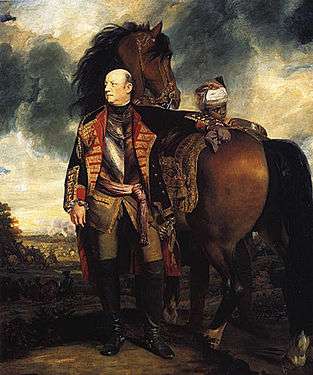 The Marquess of Granby, Joshua Reynolds, now in the National Army Museum
The Marquess of Granby, Joshua Reynolds, now in the National Army Museum William Shakespeare, the Chandos portrait. now in the National Portrait Gallery, London, London
William Shakespeare, the Chandos portrait. now in the National Portrait Gallery, London, London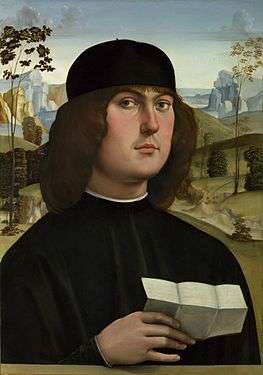 Bartolomeo Bianchini, Francesco Raibolini, now in the National Gallery
Bartolomeo Bianchini, Francesco Raibolini, now in the National Gallery

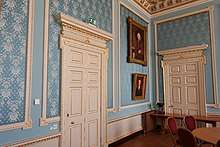
- The Blue Room[23] to the east of the Large Library, used as a small drawing room. Until the 1849 sale this was known as the Print Room and the walls were lined with bookshelves similar to those in the Large Library. These housed the extensive print collection. Over 55,000 prints were sold in 1834 at Philips auction house, but raised only £6,700. The remaining English prints were sold in March 1849 at Sotheby's for £3,800. After this sale the bookshelves were removed and replaced with panels of blue silk with matching curtains, (these were sold off in 1922), and the room assumed its present name. The plaster ceiling dated between 1774 and 1775 is decorated with emblems of Bacchus, including four thyrsi surrounding an ornate jug with a handle in the form of a satyr. Encircled by a wreath of vine-leaves and grapes. The four corners have relieves of Venus, Flora, Vulcan and Venus, the crystal chandelier is modern replacement for the original one as is the fireplace. Displayed in the room are several pieces of the 'Stowe Service' commissioned from the Worcester Porcelain Factory in 1813 by the 1st Duke while he was still a Marquess. The service was sold in two batches, 206 pieces in 1848, and the remaining 164 pieces in 1921. But as pieces have appeared on the market they have been repurchased. Also on display in the room are several family portraits that have also been bought as they have come on the market, they are The Marquess of Buckingham painted in his Garter robes by John Jackson; William Pitt the Elder by William Hoare; William Pitt the Younger by John Hoppner; a copy of Anne Chambers, Countess Temple by Allan Ramsey; Sir Peter Temple, Second Baronet by Cornelius Johnson; Sir Richard Temple, Third Baronet attributed to Henri Gascar; a photographic copy of Earl Temple by Allan Ramsey the original is in the National Gallery of Victoria; Alice Anne, Duchess of Buckingham by Sir Arthur Stockdale Cope; Viscount Cobham by Jean-Baptiste van Loo; The Third Duke of Buckingham and Chandos an engraving of the portrait by C.A. Tompkins & a possible portrait of Earl Temple by Robert Edge Pine. Also in the room are two of the original Athéniennes from the Marble Saloon.
- The Breakfast Parlour[24] Now called the Chandos Sigma Dormitory. It is immediately to the east of the Blue Room dating from 1773 to 1775. This is a relatively plain room. The ceiling is coved, centre of the ceiling is decorated with a circular painting of Venus blindfolding Cupid surrounded by plaster decoration that includes incense burners. The marble fireplace dated 1774 with its relief of Venus and Cupid was sold in 1922. There used to be 39 paintings in this room, including Virgin and Child with SS John the Baptist and Catherine, dated 1504 by Andrea Previtali this is now in the National Gallery, London and Woman at her Toilette once attributed to Leonardo da Vinci and bought as such in 1780, now School of Fontainebleau, this is in the Worcester Art Museum, Massachusetts.
- The Rembrandt Room[25] Now called the Chandos Delta Dormitory. Immediately to the east of the Breakfast Parlour, originally dated 1748, the room was extended and redecorated in 1775. In a relatively plain room, the painting that used to be in the centre of the ceiling, Venus at her toilet by Vincenzo Valdrè was sold in 1922 along with the marble chimneypiece with its central relief of Hebe and Jupiter's Eagle. The room once contained eleven paintings attributed to Rembrandt although only three are considered so now, the rest being School of Rembrandt. All the paintings were sold in 1848. They included: Samson Threatening his Father-in-law, in 1989 this was sold by the estate of the late P Chrysler Jr; Bellona now in the Metropolitan Museum of Art; Self-Portrait as a Young man now in the Isabella Stewart Gardner Museum; Eleazor Swalmius now in the Royal Museum of Fine Arts, Antwerp; A Young Negro Archer and (genuine Rembrandt) The Centurion Cornelius sold for £2,300 (the highest price any of the paintings sold in 1848 fetched) both now in the Wallace Collection. Also originally in this room and now in the Wallace Collection are the almost 10 feet (3.0 m) high astronomical regulator clock by Michael Stollewerck formerly at the Palace of Versailles and a Boulle armoire. Also from this room was a German marquetry cabinet, later bought by Mayer Amschel de Rothschild for Mentmore Towers. It was in this room that Queen Victoria and her husband slept during their visit, redecorated for the occasion, including the purchase of the largest Persian carpet in the country, 25.5 by 16 feet (4.9 m), this cost £200, but only fetched £55 in the 1848 sale. The 2nd Duke spent £5,300 on redecorating the house and on entertaining the royal couple for a visit that lasted a few days.
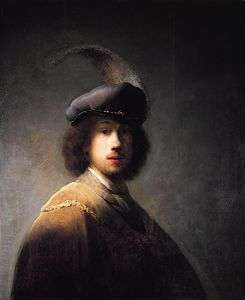 Rembrandt van Rijn, Self portrait, now in the Isabella Stewart Gardner Museum
Rembrandt van Rijn, Self portrait, now in the Isabella Stewart Gardner Museum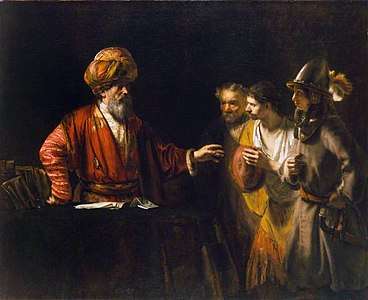 Rembrandt van Rijn, The Centurion Cornelius, now in the Wallace Collection
Rembrandt van Rijn, The Centurion Cornelius, now in the Wallace Collection- School of Rembrandt, Eleazar Swalmius, now in the Royal Museum of Fine Arts Antwerp
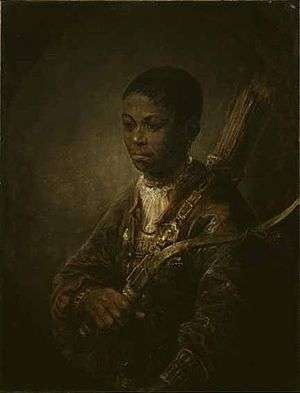 Govaert Flinck, A Young Archer, now in the Wallace Collection
Govaert Flinck, A Young Archer, now in the Wallace Collection Rembrandt's Bellona now in the Metropolitan Museum of Art
Rembrandt's Bellona now in the Metropolitan Museum of Art
- The Chapel[26] located immediately behind the Eastern Pavilion, created in 1742–1748 and originally rising through two floors. The room was divided into two floors in 1929 when the new school chapel was built, all the timber panelling being reused in the new chapel. Only the plaster ceiling decoration survives, this consists of octagons, crosses and hexagons. The elaborate carved wood panelling of cedarwood came from a house in Cornwall also called Stowe. It had been carved by Michael Chuke a pupil of Grinling Gibbons. The most elaborate pieces of carving were the gallery on the south side, the octagonal pulpit dated 1707 and the elaborate reredos that reached nearly the full height of the room, the lower half having two Corinthian columns flanking the altar above which used to hang a copy of Rubens's painting of 'Holy Lamb'. This in turn was flanked by rich carving of fruit and plants. Above was a very rich carving of the Royal Arms.
- The Gothic Library[27] is situated on the ground floor beneath the centre part of the Large Library, created in 1805. This was the last major interior to be added to the house. Designed by Sir John Soane. The plaster ceiling pattern is based on a very shallow fan vault. The plasterer was one William Rothwell, who charged £495 10 shillings & 7 pence. The centre of the ceiling contains a circular panel 4 feet 6 inches (1.37 m) in diameter that contains 726 painted armorial bearings of the various families that the then Marquess was descended. the wooden bookshelves include glazed bronze doors based on the bronze screen around Henry VII's tomb in Westminster Abbey. The fireplace was supplied by a brass-founder Thomas Catherwood in 1807 for £100. This room used to contain amongst other treasures 1085 Saxon & Irish manuscripts, the Saxon Manuscripts were inherited from Thomas Astle under the terms of his will in 1803 on payment of £500, the Irish manuscripts were purchased from Charles O'Conor in 1804. These are now either in the British Library or Royal Irish Academy including the Stowe Missal. The manuscripts now in the British Library include The Medieval Bestiary, Stowe MS 1067 and the Psalter, Stowe 2 (Psalter). The room was furnished with ebonized mahogany tables and chairs inlaid with ivory, one of the tables is now in the collection of the Victoria and Albert Museum. The door from the library has on the outside a carved stone relief dated to the late 16th century, above it, of The Battle of Bosworth Field, the Gothic Staircase by the door connects the two libraries.
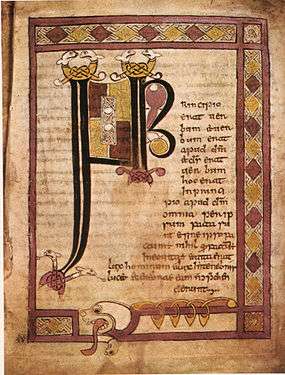 Initial Page from Stowe Missal, now in the Royal Irish Academy, Dublin
Initial Page from Stowe Missal, now in the Royal Irish Academy, Dublin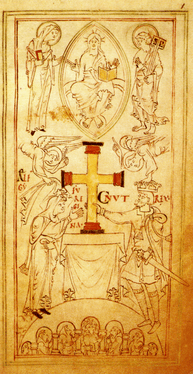 King Canute & Queen Ælfgifu from Stowe Ms 944, folio 6, now in The British Library
King Canute & Queen Ælfgifu from Stowe Ms 944, folio 6, now in The British Library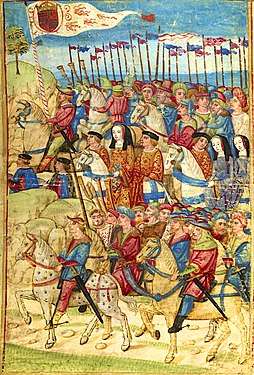 Anne de Foix, from Stowe Ms 584, folio 71v, now in The British Library
Anne de Foix, from Stowe Ms 584, folio 71v, now in The British Library%2C_f.8_-_BL_Stowe_MS_594_(cropped).jpg) Henry of Grosmont, first duke of Lancaster, from the Bruges Garter Book, Stowe Ms 594, folio 8, now in The British Library
Henry of Grosmont, first duke of Lancaster, from the Bruges Garter Book, Stowe Ms 594, folio 8, now in The British Library
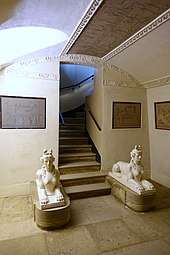
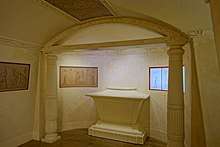
- The Egyptian Hall[28] created c.1803, it is situated beneath the North Hall to which it is connected by the staircase by the east wall which was inserted at this time, and was created as the winter entrance, linked to the Porte-cochère created at the same time, beneath the North Portico with ramps connecting to the forecourt to allow carriages to pick up and set down passengers under cover. Decorated in the Egyptian style of decoration. The room has inward sloping walls and a vaulted ceiling, the western end of the room has a recess flanked by two Egyptian style lotus columns that originally contained a heating stove in the form of a carved sarcophagus, removed in 1922. The frieze around the ceiling is decorated with a winged solar disk, the symbol of the god Ra and uraeus between falcon wings, alternate with Ankh the symbol of life flanked by sceptres symbols of power. There is an illuminated sun globe over the south door. Also sold in 1922 were seven canvas sepia paintings on the walls which depicted Egyptian figures and hieroglyphics and two sculptures of Sphinxes that used to be at the base of the staircase. The designer of the room is not known for certain, though Sir John Soane implied in a lecture that the 1st Marquess was responsible for the concept. In 2012 all the missing decoration and sculpture was recreated, returning the room to its original form.
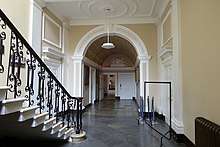
- The East Corridor and Grand staircase[29] Dating from the 1730s, connects the North Hall via the south-east door with the Ante-Library, this is a relatively plain room, the stone staircase at the east end of the corridor is cantilevered from the walls and has a wrought iron balustrade, the ceiling above the staircase is painted with Fame and Victory, by Francesco Sleter, the same artist's wall paintings on the staircase where thought to no longer survive, but in 2016 it was discovered that beneath later paintwork the wall murals are largely intact. Small sections have been exposed, revealing a grisaille scheme of trompe-l'œil statues in niches, a decision on whether to uncover and restore the murals has yet to be taken. The walls of the corridor are now lined with paintings of former headmasters of the school and in the east window above the staircase there is white marble bust a copy of the head of the Apollo Belvedere. There used to be forty-five paintings on the walls, including: Godfrey Kneller's portrait of John, Duke of Marlborough now in the Institute of Directors; Henry Fuseli's paintings of characters from A Midsummer Night's Dream, Titania and Bottom now in Tate Britain and his Oberon wakes Titania now in the Kunstmuseum Winterthur; and attributed to John Closterman, General Michael Richards and his Brother, General John Richards, at the siege of Belgrade now in the Slovak National Gallery. Also originally in the corridor but sold in 1848 were eleven Greek vases, three from the Lucien Bonaparte's excavations at Canino, also a Roman sarcophagus dating from Trajan's reign.
- The Ante-Library[30] located immediately to the north of the Large Library, created in 1805, this is really a wide corridor, about 50 feet (15 m) long, and low in height, with a plain ceiling and walls, the fireplace on the east wall is a replacement for the carved marble one sold in 1922. The main feature of the room are the eight Tuscan columns of scagliola imitating Verd antique marble, the work of Domenico Bartoli. The room housed in 1838 a series of 52 family portraits, including: The Rt Hon. George Greville prime minister, by Sir Joshua Reynolds, now in the Bass Museum; a posthumous portrait of George, Marquess of Buckingham, by John Jackson now at Christ Church, Oxford; Mary Nugent, Marchioness of Buckingham by Sir Joshua Reynolds, last sold in 1989 and present whereabouts unknown; William Wyndham, Lord Grenville by John Hoppner now in the North Carolina Museum of Art.
- The Stucco Corridor and West staircase[31] Reached from the south-west door in the North Hall via the Stucco Corridor with its plaster barrel vaulted coffered ceiling is the cantilevered stone West staircase with iron balustrade, dating from the 1730s, James Gibbs is thought to be the designer.
- Other Interiors there are various smaller rooms on the main floor of the house, mainly plain in decoration but used to house many important paintings, including: two paintings of 1648 by Frans Hals, Portrait of a man now in the Art Gallery of Ontario and Portrait of a Woman now in the Museum of Fine Arts, Boston; Orazio Gentileschi's The Rest on the Flight into Egypt now in the J. Paul Getty Museum; Claude Joseph Vernet's Rocky Coast in a Storm in the Wallace Collection; Giovanni Battista Lusieri's A View of Naples over nine feet in length this water colour remained in the house until sold in 1985 to the J. Paul Getty Museum; Joshua Reynold's painting of the Marquess of Buckingham was sold by Lady Kinloss in 1899 and is now in the National Gallery of Ireland; John Martin's The Destruction of Pompeii and Herculaneum now in the Tate Britain collection, originally thought to be destroyed in 1928 when the Thames flooded the gallery basement, it has since been rediscovered and restored in 2010–2011; Jan van Huysum's self-portrait now in the Ashmolean Museum; Aert de Gelder's The Temple Entrance now in the Mauritshuis.
 Aert de Gelder's The Temple Entrance now in the Mauritshuis
Aert de Gelder's The Temple Entrance now in the Mauritshuis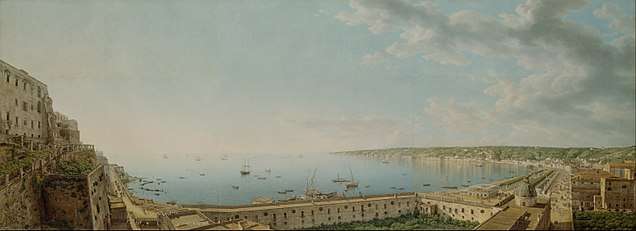 Giovanni Battista Lusieri's A View of Naples now in the J. Paul Getty Museum
Giovanni Battista Lusieri's A View of Naples now in the J. Paul Getty Museum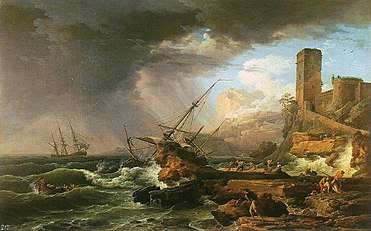 Claude Joseph Vernet's Rocky Coast in a Storm now in the Wallace Collection
Claude Joseph Vernet's Rocky Coast in a Storm now in the Wallace Collection Orazio Gentileschi's Rest on the Flight into Egypt now in the J. Paul Getty Museum
Orazio Gentileschi's Rest on the Flight into Egypt now in the J. Paul Getty Museum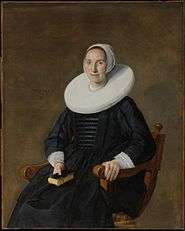 Frans Hals's "Portrait of a Woman" now in the Boston Museum of Fine Arts
Frans Hals's "Portrait of a Woman" now in the Boston Museum of Fine Arts
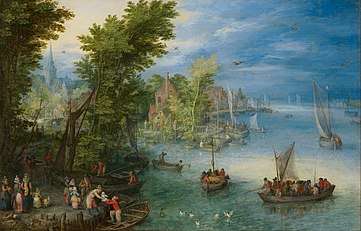 Jan Brueghel the Elder's River landscape, now in the National Gallery of Art
Jan Brueghel the Elder's River landscape, now in the National Gallery of Art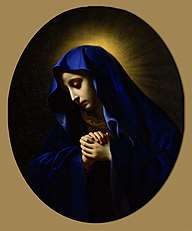 Carlo Dolci's Mater Dolorosa, now in National Museum of Western Art
Carlo Dolci's Mater Dolorosa, now in National Museum of Western Art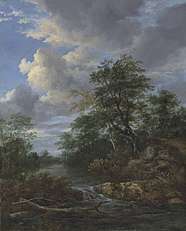 Jacob van Ruisdael's A wooded river landscape with a family at rest on a track, now in a private collection
Jacob van Ruisdael's A wooded river landscape with a family at rest on a track, now in a private collection
Other areas of the house
The house contains over 400 rooms. The ground floor rooms to the east of the Gothic Library were used by the family as personal rooms including the Billiard room, Sitting room, Water closet, Manuscript room, Gun room and Plunge pool. The rest of the ground floor was given over to the service areas. The house has low wings that are set back and project from the east and west pavilions of the south front. These extend north before projecting even further east and west. The full length of the house is over 900 feet (270 m). These wings to the east included the riding school, coach houses and at the extreme east the stables designed by Vanbrugh. The west area includes the kitchen (still used as such by the school), the laundry, the dairy and at the extreme west the 138-foot-long (42 m) orangery, designed by Vanbrugh. Although the Central Pavilion of the south front appears to be only two floors high, there are in fact bedrooms over the State Music & Drawing rooms, these are lit by windows facing respectively east and west. The centre is filled by the Marble Saloon which rises to the full height of the building. There are more bedrooms on the 1st, 2nd and 3rd floors of the north front, and the west and east pavilions of the south front, where the 2nd floor is disguised in the same way as in the central pavilion.
The restoration of the house and gardens
Since the 1848 sale the maintenance of the house and gardens was neglected. Though the school tried its best it was obvious by the 1980s that a major restoration was needed. On taking over ownership of the gardens the National Trust commissioned a survey on which to base a restoration strategy. Individual trees, boundaries, buildings, lakes, paths and fences were mapped. The first principle was to keep all buildings and planted features that were in existence by the time the last plan of the garden in 1843 was created. Another was to restore the main views and axes of the garden. The process was greatly helped by the Stowe Papers, some 350,000 documents that are now in the collection of the Huntington Library, containing extensive and detailed information on the creation of both the house and gardens.
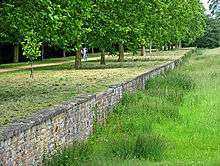
The first large-scale operation was to dredge the lakes and other water features. 320,000 tonnes of silt had to be removed. The wall of the ha-ha had largely collapsed and had to be rebuilt by hand. It was also found that very few trees survived before the 3rd Duke's time; he had all the mature trees felled to sell for their timber in order to raise cash. There had been a few plantings of commercial softwood, including a spruce plantation on the site of the Saxon Deities (largely by John Michael Rysbrack placed 1728–1730). These were felled. Further thinning was carried out, including reopening views between the various buildings and monuments. Replanting of 20,000 trees and shrubs followed, using species present in the original garden. Paths which had become overgrown were re-excavated and eventually covered in gravel from local pits.
Over 100 pieces of statuary had been sold from the gardens in 1848, 1921 and 1922, so it was decided to replace them gradually with replicas as and when funds could be raised. In 1989–90 Peter Inskip assessed the condition of the buildings. Work on the restoration of the buildings, based on this survey, was then prioritised. The major restorations have been the Grenville Column (1991), the Temple of Ancient Virtue (1992), the Oxford Gates and Lodges (1994), the Temple of Venus (1995) and the Temple of Concord & Victory (1996). This last had been severely compromised when 16 columns had been removed to build the new school chapel in 1926. Replacement columns were carved and the building re-roofed at the cost of £1,300,000. The cost of this first stage was £10,000,000, the money coming from several sources: a public appeal, the Heritage Lottery Fund and grants from English Heritage as well as private donors and other grant-giving bodies. The restoration process adopted an approach where each building, or element of the gardens was informed by archaeology. In order to make informed decisions about what to restore and why, archaeological techniques such as geophysics, excavation, building recording and monitoring in the form of an archaeological watching brief were all utilised.
In 2002 the World Monuments Fund placed Stowe House on its List of Most Endangered Sites. The school had done its best to keep the house in good repair, including re-roofing the State Dining Room in 1990, repair of the north elevation of the West Pavilion in 1992 and the repair of the Marble Saloon's oculus skylight in 1994. On taking over ownership of the house in 1997, the Stowe House Preservation Trust commissioned a survey in order to scope the problem and come up with a restoration plan. The result was a six-phase plan, starting with the most urgent work. The estimated cost in 2002 for all six phases was nearly £40 million.
The phases are: Phase 1, the restoration of the North Front and Colonnades, started in the summer of 2000 and completed in July 2002, much of the money coming from the Heritage Lottery Fund, English Heritage, the Getty Grant Programme and Shanks First Fund. Phase 2, the restoration of the Central Pavilion and South Portico, took place from July 2003 to July 2006, thanks to funding by an anonymous U.S. philanthropist; the interior of the Marble Saloon was also undertaken. Phase 3, the restoration of the South Front, commenced in the autumn of 2009 and has been divided into sub-phases A, The Large Library roof, facades and ceiling completed July 2010; B, The Eastern Pavilion roof, facades and garden, completed July 2010; C, The Western Pavilion roof, and facades; D, The State Dining room, roof, facades, ceiling and garden. If the funds can be raised it is hoped to complete Phase 3 in 2011 or 2012. Phase 4, the restoration of the West court and building range. Phase 5, the restoration of the Eastern court and building range. Phase 6, the restoration of the State Rooms (the Marble Saloon, Ante-Library and Large Library have been restored, as were the Music Room and Egyptian Hall in 2012, followed by the Blue Room in 2014, and the Grand Staircase in 2017, as of 2019 work is underway to restore the North Hall).
Stowe Landscape Gardens
The history of the gardens
In the 1690s, Stowe had a modest early-baroque parterre garden, owing more to Italy than to France, but it has not survived, and, within a relatively short time, Stowe became widely renowned for its magnificent gardens created by Lord Cobham. The Landscape garden was created in three main phases, showing the development of garden design in 18th-century England (this is the only garden where all three designers worked):
- From 1711 to c.1735 Charles Bridgeman was the garden designer[32] and John Vanbrugh the architect[33] from c.1720 until his death in 1726. They designed an English baroque park, inspired by the work of London, Wise and Switzer. After Vanbrugh's death James Gibbs took over as architect in September 1726.[34] He also worked in the English Baroque style.
- In 1731 William Kent was appointed[35] to work with Bridgeman, whose last designs are dated 1735 after which Kent took over as the garden designer. Kent had already created the glorious garden at Rousham House, and he and Gibbs built temples, bridges, and other garden structures. Kent's masterpiece at Stowe is the Elysian Fields with its Temple of Ancient Virtue that looks across to his Temple of British Worthies. Kent's architectural work was in the newly fashionable Palladian style.
- In March 1741, Capability Brown was appointed head gardener.[36] He worked with Gibbs until 1749 and with Kent until the latter's death in 1748. Brown departed in the autumn of 1751 to start his independent career as a garden designer.[37] In these years, Bridgeman's octagonal pond and 11-acre (4.5 ha) lake were extended and given a "naturalistic" shape, and a Palladian bridge was added in 1744, probably to Gibbs's design. Brown contrived a Grecian valley which, despite its name, is an abstract composition of landform and woodland, and developed the Hawkwell Field, with Gibbs's most notable building, the Gothic Temple (now one of the properties leased from the National Trust but maintained by The Landmark Trust).[38] As Loudon remarked in 1831, "nature has done little or nothing; man a great deal, and time has improved his labours".
After Brown left, Earl Temple, who had inherited Stowe from his uncle Lord Cobham, turned to a garden designer called Richard Woodward,[6] who had been gardener at Wotton House, the Earl's previous home. The work of naturalising the landscape started by Brown was continued under Woodward and was accomplished by the mid-1750s. At the same time Earl Temple turned his attention to the various temples and monuments. He altered several of Vanburgh's and Gibbs's temples to make them conform to his taste for Neoclassical architecture. To accomplish this he employed Giovanni Battista Borra from 1752 to 1756. Also at this time several monuments were moved to other parts of the garden. Earl Temple made further alterations in the gardens from the early 1760s. This is when several of the older structures were demolished and this time he turned to his cousin Thomas Pitt, 1st Baron Camelford who was assisted by Borra, whose most notable design was the Corinthian Arch.
_-_geograph.org.uk_-_855893.jpg)
The next owner of Stowe, the Marquess of Buckingham, made relatively few changes to the gardens. He planted the two main approach avenues, added 28-acre (11 ha) to the garden east of the Cobham Monument and altered a few buildings. Vincenzo Valdrè was his architect and built a few new structures such as The Menagerie with its formal garden and the Buckingham Lodges at the southern end of the Grand Avenue, and most notably the Queen's Temple. He also created the formal gardens within the balustrade he added to the south front of the house and demolished a few more monuments in the gardens.
The last significant changes to the gardens were made by the next two owners of Stowe, the 1st and 2nd Dukes of Buckingham and Chandos. The former succeeded in buying the Lamport Estate in 1826, which was immediately to the east of the gardens, adding 17 acres (6.9 ha) to the south-east of the gardens to form the Lamport gardens. This work was overseen by the head gardener, James Brown, who remodelled the eastern arm of the Octagon Lake and created a cascade beyond the Palladian Bridge. From 1840 the 2nd Duke of Buckingham's gardener Mr Ferguson created rock and water gardens in the new garden. The architect Edward Blore was also employed to build the Lamport Lodge and Gates as a carriage entrance, and also remodelled the Water Stratford Lodge at the start of the Oxford Avenue.


As Stowe evolved from an English baroque garden into a pioneering landscape park, the gardens became an attraction for many of the nobility, including political leaders. Indeed, Stowe is said to be the first English garden for which a guide book was produced. Wars and rebellions were reputedly discussed among the garden's many temples; the artwork of the time reflected this by portraying caricatures of the better-known politicians of history taking their ease in similar settings. Stowe began to evolve into a series of natural views to be appreciated from a perambulation rather than from a well-chosen central point. In their final form the Gardens were the largest and most elaborate example of what became known in Europe as the English garden. The main gardens, enclosed within the ha-has (sunken or trenched fences) over four miles (6 km) in length, cover over 400 acres (160 ha),[39] but the park also has many buildings, including gate lodges and other monuments.
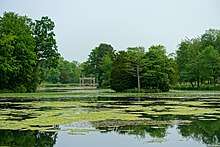
Many of the temples and monuments in the garden celebrate the political ideas of the Whig party and include quotes by many of the writers who are part of Augustan literature, also philosophers and ideas belonging to the Age of Enlightenment.
The fame of the gardens was spread by various means.
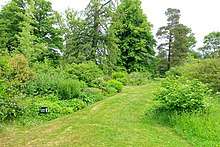
.jpg)
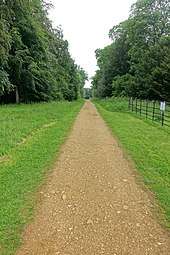
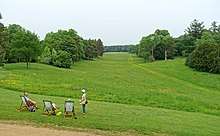
.jpg)
.jpg)
.jpg)
.jpg)
Alexander Pope who first stayed at the house in 1724, wrote the following passage celebrating the design of Stowe as part of a tribute to Richard Boyle, 3rd Earl of Burlington. The full title of the 1st edition (1731) was An Epistle to the Right Honourable Richard Earl of Burlington, Occasion'd by his Publishing Palladio's Designs of the Baths, Arches, Theatres, &c. of Ancient Rome. This passage consists of lines 47–70 of the poem.
To build, to plant, whatever you intend,
To rear the Column, or the Arch to bend,
To swell the Terras, or to sink the Grot;
In all, let Nature never be forgot.
But treat the Goddess like a modest fair,
Nor over-dress, nor leave her wholly bare;
Let not each beauty ev'ry where be spy'd,
Where half the skill is decently to hide.
He gains all points who pleasingly confounds
Surprises, varies, and conceals the Bounds.
Consult the Genius of the Place in all;
That tells the Waters or to rise, or fall,
Or helps th' ambitious Hill the heav'n to scale,
Or scoops in circling theatres the Vale,
Calls in the Country, catches opening glades,
Joins willing woods, and varies shades from shades,
Now breaks or now directs th' intending Lines;
Paints as you plant, and, as you work, designs.
Still follow Sense, of ev'ry Art the Soul,
Parts answ'ring parts shall slide into a whole,
Spontaneous beauties all around advance,
Start ev'n from Difficulty, strike from Chance;
Nature shall join you, Time shall make it grow
A Work to wonder at—perhaps a STOWE.

In 1730 James Thomson published his poem Autumn, part of his four works The Seasons, these are lines 1033–81, which are about Stowe:
Oh! bear me then to vast embowering shades,
To twilight groves, and visionary vales,
To weeping grottoes, and prophetic glooms!
Where angel forms athwart the solemn dusk
Tremendous sweep, or seem to sweep along;
And voices more than human, through the void
Deep-sounding, seize the enthusiastic ear.
Or is this gloom too much? Then lead, ye powers
That o'er the garden and the rural seat
Preside, which shining through the cheerful land
In countless numbers blest Britannia sees,
Oh lead me to the wide-extended walks,
The fair majestic paradise of Stowe!
Not Persian Cyrus on Ionia's shore
E'er saw such sylvan scenes; such various art
By genius fired, such ardent genius tamed
By cool judicious art – that in the strife,
All-beauteous Nature fears to be outdone.
And there, O Pitt, thy country's early boast,
There let me sit beneath the sheltered slopes,
Or in that temple where, in future times,
Thou well shalt merit a distinguished name;
And with thy converse blest, catch the last smiles
Of Autumn beaming o'er the yellow woods.
While there with thee the enchanted round I walk,
The regulated wild, gay fancy then
Will tread in thought the groves of Attic land;
Will from thy standard taste refine her own,
Correct her pencil to the purest truth
Of Nature, or, the unimpassioned shades
Forsaking, raise it to the human mind.
Or if hereafter she, with juster hand,
Shall draw the tragic scene, instruct her thou,
To mark the varied movements of the heart,
What every decent character requires,
And every passion speaks – oh! through her strain
Breathe thy pathetic eloquence! that moulds
The attentive senate, charms, persuades, exalts,
Of honest zeal the indignant lightning throws,
And shakes corruption on her venal throne.
While thus we talk, and through Elysian vales
Delighted rove, perhaps a sigh escapes;
What pity, Cobham, thou thy verdant files
Of ordered trees shouldst here inglorious range,
Instead of squadrons flaming o'er the field,
And long embattled hosts! when the proud foe,
The faithless vain disturber of mankind,
Insulting Gaul, has roused the world to war;
When keen, once more, within their bounds to press
Those polished robbers, those ambitious slaves,
The British youth would hail thy wise command,
Thy tempered ardor, and thy veteran skill
In 1732 Lord Cobham's nephew Gilbert West wrote a lengthy poem, The Gardens of the Right Honourable Richard Viscount Cobham, that is actually a guide to the gardens in verse form. Charles Bridgeman commissioned 15 engravings of the gardens from Jacques Rigaud which were published in 1739. In 1744 Benton Seeley published A Description of the Gardens of Lord Cobham at Stow Buckinghamshire. In 1748 William Gilpin produced the Views of the Temples and other Ornamental Buildings in the Gardens at Stow followed in 1749 by A Dialogue upon the Gardens at Stow. Unlicensed copies of all three books were published in 1750 by George Bickham as The Beauties of Stow. To cater to the large number of French visitors, a French guidebook, Les Charmes de Stow, was published in 1748. In the 1750s Jean-Jacques Rousseau had visited the gardens and his writings about the gardens helped spread their fame and influence throughout Europe. He had this to say[40] 'Stowe is composed of very beautiful and very picturesque spots chosen to represent different kinds of scenery, all of which seem natural except when considered as a whole, as in the Chinese gardens of which I was telling you. The master and creator of this superb domain has also erected ruins, temples and ancient buildings, like the scenes, exhibit a magnificence which is more than human'. Georges-Louis Le Rouge published in 1777 Détails de nouveaux jardins à la mode that included engravings of buildings at Stowe as well as at other famous gardens in Britain. In Germany Christian Cay Lorenz Hirschfeld published Theorie der Gartenkunst in 5 volumes in Leipzig 1779–1785, that included Stowe. The last edition of the Seeley guide was published in 1827. In 1805-9 John Claude Nattes painted 105 wash drawings of both the house and gardens.
The main divisions of the garden are:
The approaches
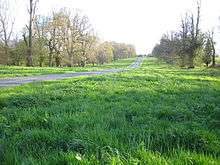
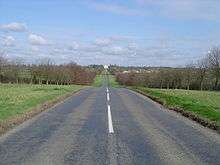
There are two main entrances to the Park, the Grand Avenue, from Buckingham to the south and the Oxford Avenue from the south-west, which leads to the forecourt of the house. The Grand Avenue was created in the 1770s, 100 feet (30 m) in width and one and half miles in length, lined originally with elm trees. The elms succumbed in the 1970s to Dutch elm disease and were replaced with alternate beech & chestnut trees. The Grand Avenue by the Corinthian Arch turns to the west to join the Queen's Drive that connects to the Oxford Avenue just below the Boycott Pavilions. The Oxford Avenue was planted in the 1790s, and sold to the National Trust in 1985 by the great-great grandson of the 3rd Duke, Robert Richard Grenville Close-Smith (1936–1992), a local landowner. Close-Smith was the grandson of the Honourable Mrs. Caroline Mary Close-Smith, who was the 11th Lady Kinloss's daughter. This was one of the first acquisitions of the Trust at Stowe.
The buildings in this area are:
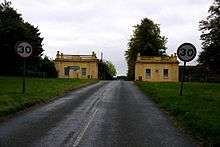
- The Buckingham Lodges.[41] 2.25 miles south-southeast of the centre of the House. Probably designed by Vincenzo Valdrè and dated 1805, they flank the southern entrance to the Grand Avenue.
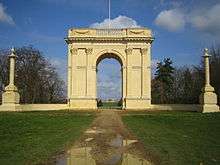
- The Corinthian Arch,[42] designed in 1765 by Thomas Pitt, 1st Baron Camelford, Lord Temple's cousin. Built from stone 60 feet (18 m) in height and 60 feet (18 m) wide, it is modelled on ancient Roman triumphal arches. This is located at the northern end of the Grand Avenue 0.8 miles south-southeast of the centre of the House and is on the top of a hill. The central arch is flanked on the south side by paired Corinthian pilasters and on the north side by paired Corinthian engaged columns. The arch contains two four-storey residences originally for game-keepers. The flanking Tuscan columns were added in 1780.
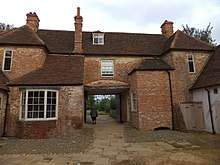
- The New Inn situated about 100 metres to the east of the Corinthian Arch. Built in 1717 specifically to provide accommodation for visitors to the gardens, the red brick Inn included a mini brewery where barley was brewed into beer, a farm and dairy. The Inn closed in the 1850s, it then being used as a farm, smithy and kennels for deer hounds. The building was purchased in a ruinous condition by the National Trust in 2005. In 2010 work started on converting it into the new visitor centre, and since 2011 this has been the entrance for visitors to the gardens. They formerly used The Oxford Gates. The New Inn is linked by the Bell Gate Drive to the Bell Gate next to the eastern Lake Pavilion, so called because visitors had to ring the bell by the gate to gain admittance to the Garden.
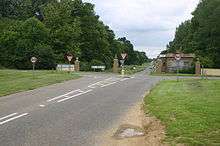
- The Water Stratford Lodge is located over a mile from the house near the border with Oxfordshire, at the very start of the Oxford Avenue, by the village of the same name. Built in 1843, the single storey lodge is in Italianate style with a porch flanked by two windows, the dressings are of stone, with rendered walls. The architect was Edward Blore.

- The Oxford Gates.[43] The central piers were designed by William Kent in 1731, for a position to the north-east between the two Boycott Pavilions,[44] they were moved to their present location in 1761, and iron railings added either side. Pavilions at either end were added in the 1780s to the design of the architect Vincenzo Valdrè. The piers have coats of arms in Coade stone manufactured by Eleanor Coade.
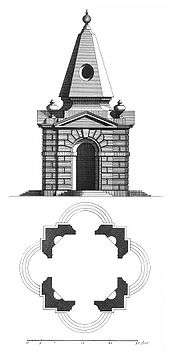
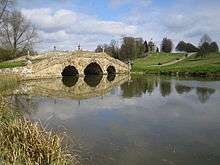
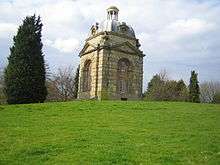
- The Oxford Bridge,[43] built in 1761 to cross the river Dad after this had been dammed to form what was renamed the Oxford Water, was probably designed by Earl Temple. It is built of stone and is of hump-backed form, with three arches, the central one being slightly wider and higher than the flanking ones. With a solid parapet, there are eight decorative urns placed at the ends of the parapets and above the two piers.
- The Boycott Pavilions[45] built of stone and designed by James Gibbs, the eastern one built in 1728 and the western in 1729. They are named after the nearby vanished hamlet of Boycott. Located on the brow of a hill overlooking the river Dad, they flank the Oxford drive. Originally both were in the form of square planned open belvederes with stone pyramidal roofs. In 1758 the architect Giovanni Battista Borra altered them, replacing them with the lead domes, with a round dormer window in each face and an open roof lantern in the centre. The eastern pavilion was converted into a three-storey house in 1952.
The forecourt
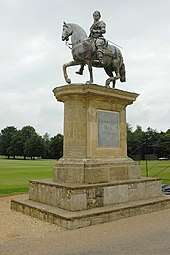
Located in front of the north facade of the house, this has in its centre:
- The Statue of George I[46] a greater than life size equestrian statue of King George I by Andries Carpentière, located in the middle of the Forecourt, made of cast lead in 1723. It is on a tall stone plinth. It was this monarch that gave lord Cobham his title of viscount in 1718 and restored his military command, leading to his involvement in the Capture of Vigo.
The south vista

This includes the tree-flanked sloping lawns to the south of the House down to the Octagon Lake and a mile and a half beyond to the Corinthian Arch beyond which stretches the Grand Avenue of over a mile and a half to Buckingham. This is the oldest area of the gardens. There were walled gardens on the site of the south lawn from the 1670s that belonged to the old house. These gardens were altered in the 1680s when the house was rebuilt on the present site. They were again remodelled by Bridgeman from 1716. The lawns with the flanking woods took on their current character from 1741 when 'Capability' Brown re-landscaped this area.
The buildings in this area are:

- The Doric Arch[47] of stone erected in 1768 for the visit of Princess Amelia, probably to the design of Thomas Pitt, 1st Baron Camelford, is a simple arch flanked by fluted Doric pilasters, with an elaborate entablature with triglyphs and carved metopes supporting a tall attic. This leads to the Elysian fields.
%2C_Stowe_-_Buckinghamshire%2C_England_-_DSC07039.jpg)
- Statue of George II on the western edge of the lawn was rebuilt in 2004 by the National Trust. This is a monument to King George II, originally built in 1724 before he became king. The monument consists of an unfluted Corinthian column on a plinth over 30 feet (9.1 m) high that supports the Portland stone sculpture of the King which is a copy of the statue sold in 1921. The pillar has this inscription from Horace's Ode 15, Book IV:
Crevere Vires, Famaque & Imperi
Porrecta Majestas ad ortum
Solis ab Hesperio Cubili
Custode rerum Cæsare
GEORGIO AUGUSTO.
(Under the care of Cæsar's scepter'd hand,
With strength and fame increas'd, this favour'd Land
The Majesty of her vast Empire spread,
From the Sun rising to his Western bed.)
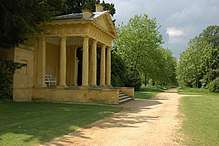
- The Lake Pavilions[48] these were designed by Vanbrugh in 1719, they are on the edge of the ha-ha flanking the central vista through the Park to the Corinthian Arch. They were moved further apart in 1764 and their details made neo-classical by the architect Borra. Raised on a low podium they are reached by a flight of eight steps, they are pedimented of four fluted Doric columns in width by two in depth, with a solid back wall and with coffered plaster ceiling. Behind the eastern pavilion is the Bell Gate. This was used by the public when visiting the gardens in the 18th and 19th centuries.
The Elysian fields
The Elysian Fields is to the immediate east of the South Vista; designed by William Kent, work started on this area of the gardens in 1734. The area covers about 40 acres (16 ha). There is a series of buildings and monuments surrounding two narrow lakes, called the river Styx, that step down to a branch of the Octagon Lake. The adoption of the name alludes to Elysium, and the monuments in this area are to the virtuous dead of both Britain and ancient Greece. The main species of trees originally planted included alder, elm, chestnut and pine also ivy was planted and encouraged to grow over dead tree-trunks to create a suitable melancholy mood. The buildings in this area are:
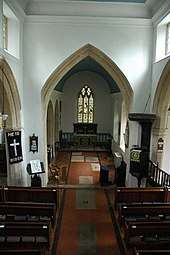
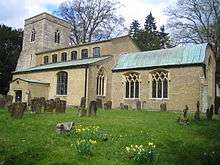
- Saint Mary's Church – located in the woods between the House and the Elysian Fields is Stowe parish church. This is the only surviving structure from the old village of Stowe. Dating from the 14th century, the building consists of a nave with aisles and a west tower, a chancel with a chapel to the north and an east window c. 1300 with reticulated tracery. Lancelot "Capability" Brown was married in the church in 1744. The church contains a fine Sir Laurence Whistler CBE etched glass window in memory of The Hon. Mrs. Thomas Close-Smith of Boycott Manor, eldest daughter of the 11th Lady Kinloss, who was the eldest daughter of the 3rd Duke of Buckingham and Chandos. Thomas Close-Smith himself was the High Sheriff of Buckinghamshire in 1942, and died in 1946.[49] Caroline Mary, his wife, known as May, died in 1972[50]
- The Temple of Ancient Virtue[51] built in 1737 to the designs of Kent, in the form of a Tholos, a circular domed building surrounded by columns. In this case they are unfluted Ionic columns, 16 in number, raised on a podium. There are twelve steps up to the two arched doorless entrances. Above the entrances are the words Priscae virtuti (to Ancient Virtue). Within are four niches one between the two doorways. They contain four life size sculptures (plaster copies of the originals by Peter Scheemakers paid for in 1737, they were sold in 1921). They are Epaminondas (general), Lycurgus (lawmaker), Homer (poet) and Socrates (philosopher). The two interior inscriptions above the doors are: Charum esse civem, bene de republica merei, laudari, coli, diligi, gloriosum est; metui vero, & in odio esse, invidiosum, detestabile, imbecillum, caducum. (To be dear to our country, to deserve well of the State, to be praised, honoured and beloved, is glorious; but to be dreaded and hated is a matter of illwill, detestable, weak, ruinous); and Justutiam cile & pietatum, quae cum sit magna in parentibus & propinquis, tum in patria maxima est. Ea vita est in coelum, & in huc coetum eorum, qui jam vixerunt. (Maintain justice and thy relative duty; which, as it is great, when exercised towards our country. That life is the way of heaven and to this Assembly of those who have already lived).
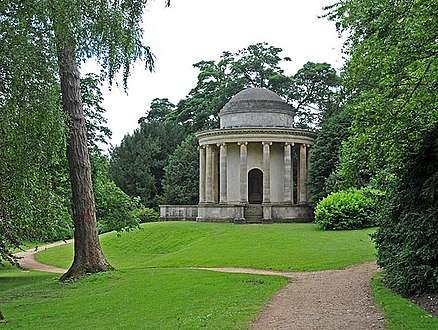 The Temple of Ancient Virtue
The Temple of Ancient Virtue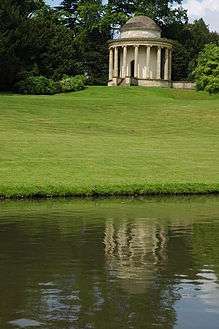 The Temple of Ancient Virtue
The Temple of Ancient Virtue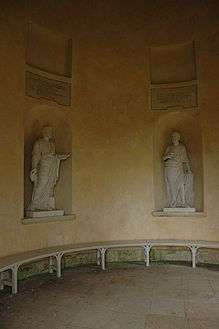 Interior, the Temple of Ancient Virtue
Interior, the Temple of Ancient Virtue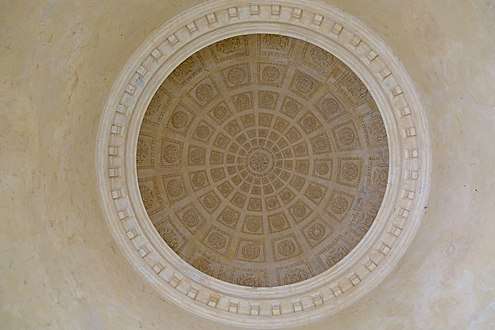 Interior of the dome, the Temple of Ancient Virtue
Interior of the dome, the Temple of Ancient Virtue
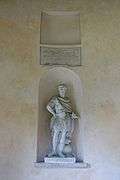 Epaminondas
Epaminondas<poem>I. EPAMINODAS Cujus a virte, prudentia, verecundia, Thebanorum republica Libertatem simul &>
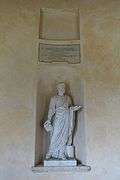 Lycurgus
Lycurgus<poem>ii. LYCURGUS Qui summo cum consilio, inventis legibus, Omnnemque contra corruptelam munitis optime Pater patriae,
 Socrates
Socrates<poem>iii. SOCRATES Qui corruptissima in civitate innocens, Bonorum hortator, unici cultor DEI, Ab inutili otio, & vanis
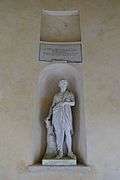 Homer
Homer<poem>iv. HOMERUS Qui poetarum princeps, idem & maximus. Virtutis praeco, & immortalitatis
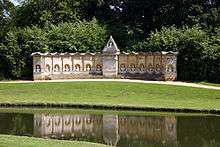
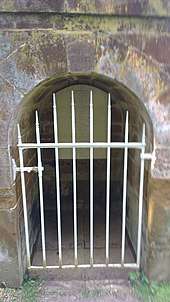
- The Temple of British Worthies[52] designed by Kent and built 1734–1735. Built of stone, it is a curving roofless exedra with a large stone pier in the centre surmounted by a stepped pyramid containing an oval niche that contains a bust of Mercury, a copy of the original. The curving wall contains 6 niches either side of the central pier. With further niches on the two ends of the wall and two more behind. These are filled by busts, half carved by John Michael Rysbrack these are John Milton, William Shakespeare, John Locke, Sir Isaac Newton, Sir Francis Bacon, Elizabeth I, William III and Inigo Jones the other eight are by Peter Scheemakers these are Alexander Pope, Sir Thomas Gresham, King Alfred the Great, The Black Prince, Sir Walter Raleigh, Sir Francis Drake, John Hampden and Sir John Barnard (Whig MP and opponent of the Whig Prime Minister Sir Robert Walpole). There is a small pediment above each niche that breaks forward slightly from the wall. There are three broad steps following the curving wall. The choice of who was considered a 'British Worthy' was very much influenced by the Whig politics of the family, the chosen individuals falling into two groups, eight known for their actions and eight known for their thoughts and ideas. At the back of the Temple is a chamber with an arched entrance containing the remains of Signor Fido with this epitaph:
To the memory of Signor Fido an Italian of good Extraction, who came to England not to bite us, like most of his countrymen, but to gain an honest livelyhood. He hunted not after fame, yet acqui'd it:
regardless of the Praise of his Friends, but most sensible of their love. Tho' he liv'd amongst the Great, he neither learnt nor flatter'd any Vice. He was no Bigot., Tho' he doubted none of 39 Articles,
And, if to follow Nature, and to respect the Laws of Society, be Philosphy, he was a perfect Philospher: A faithful Friend, an agreeable Companion, a loving Husband, distinguish'd by a numerous Offspring
all of which he liv'd to see take good Courses. in his old age he retir'd to the House of a Clergyman in the Country, where he finish'd his earthly Race, and died an Honour and an example to the whole Species
Reader, this stone is guiltless of Flattery; for he to whom it is inscrib'd was not a Man but a Greyhound.
 Sir Isaac Newton
Sir Isaac Newton<poem>Whom,
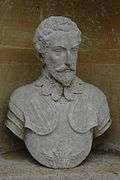 Sir Walter Raleigh
Sir Walter Raleigh<poem>A valiant Soldier, and an able Statesman;
 John Locke
John Locke<poem>Who, best of all Philosophers,
 John Hampden
John Hampden<poem>Who with great Spirit, and consummate Abilities,
 Sir Francis Drake
Sir Francis Drake<poem>Who, through many Perils, was the first of Britons
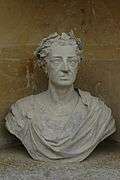 King William III
King William III<poem>Who by his Virtue and Constancy,
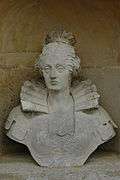 Queen Elizabeth I
Queen Elizabeth I<poem>Who confounded the Projects, and destroy'd the Power
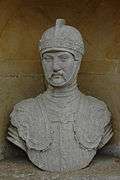 The Black Prince
The Black Prince<poem>The Terror of Europe, the Delight of England;
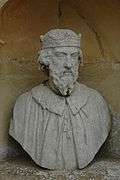 King Alfred
King Alfred<poem>The mildest, justest, most beneficent of Kings;
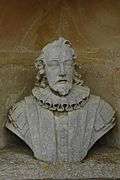 Sir Francis Bacon
Sir Francis Bacon<poem>Who by the Strength and Light of a superior Genius,
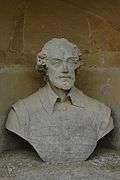 William Shakespeare
William Shakespeare<poem>Whose excellent Genius open'd to him the whole Heart of Man,
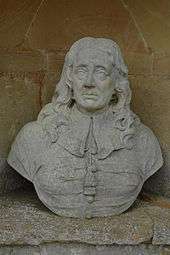 John Milton
John Milton<poem>Whose sublime and unbounded Genius equal'd a Subject
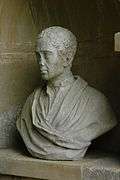 Alexander Pope
Alexander Pope<poem>Who uniting the Correctness of Judgement to the Fire of Genius,
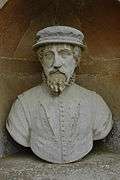 Sir Thomas Gresham
Sir Thomas Gresham<poem>Who by the honourable Profession of Merchant,
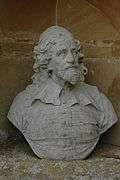 Inigo Jones
Inigo Jones<poem>Who, to adorn his Country,
 Sir John Barnard
Sir John Barnard<poem>Who distinguish'd himself in Parliament by an active & firm
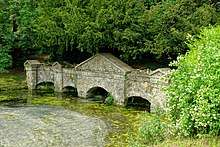
- The Shell Bridge[53] designed by Kent, and finished by 1739, is actually a dam disguised as a bridge of five arches and is decorated with shells.
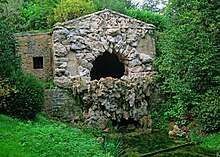
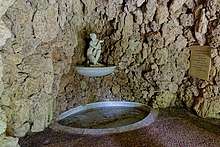
- The Grotto[54] probably designed by Kent in the 1730s, is located at the head of the serpentine 'river Styx' that flows through the Elysian Fields. There are two pavilions, one ornamented with shells the other with pebbles and flints. In the central room is a circular recess in which are two basins of white marble. In the upper is a marble statue of Venus rising from her bath, and water falls from the upper into the lower basin, there passing under the floor to the front, where it falls into the river Styx. A tablet of marble is inscribed with these lines from Milton:
Goddess of the silver wave,
To thy thick embower'd cave,
To arched walks, and twilight groves,
And shadows brown, which Sylvan loves
When the sun begins to fling
His flaring beams, me, Goddess, bring.

- The Seasons Fountain[55] probably erected in 1805, built from white statuary marble. Spring water flows from it, the basic structure is made from an 18th-century chimneypiece, it used to be decorated with Wedgwood plaques of the four seasons and had silver drinking cups suspended on either side.
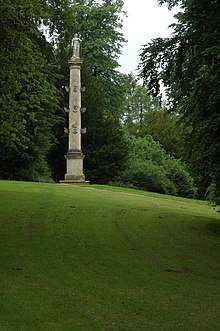
- The Grenville Column[56] originally erected in 1749 near the Grecian Valley, it was moved to its present location in 1756; Earl Temple probably designed it. It commemorates one of Lord Cobham's nephews, Captain Thomas Grenville RN killed in 1747 while fighting the French off Cape Finisterre aboard HMS Defiance under the command of Admiral Anson, the monument is based on an Ancient Roman naval monument, a rostral column, one that is carved with the prows of Roman galleys sticking out from the shaft. The order used is Tuscan, and is surmounted by a statue of Calliope holding a scroll inscribed Non nisi grandia canto (Only sing of heroic deeds); there is a lengthy inscription in Latin added to the base of the column after it was moved.
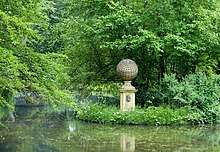
- The Cook Monument[57] was built in 1778 as a monument to Captain James Cook; it takes the form of a stone globe on a pedestal. It was moved to its present position in 1842. The pedestal has a carved relief of Cook's head in profile and the inscription Jacobo Cook/MDCCLXXVIII.
- The Gothic Cross erected in 1814 from Coade stone on the path linking the Doric Arch to the Temple of Ancient Virtue. It was erected by the 1st Duke of Buckingham and Chandos as a memorial to his mother Lady Mary Nugent. It was demolished in the 1980s by a falling elm tree. The National Trust rebuilt the cross in 2017 using several of the surviving pieces of the monument.

- The Wooden Bridge this crosses the mouth of the 'river styx' where it emptied into the 'octagon lake', rebuilt in 2012 by the National Trust in oak, it recreates a long lost bridge.
- The Marquess of Buckingham's Urn sited behind the Temple of British Worthies, erected in 1814 by the 1st Duke in memory of his father, it was moved to the school precincts in 1931, a replica urn was created and erected in 2018.
The Hawkwell Field
.jpg)
Is to the east of the Elysian Fields, also known as The Eastern Garden. This area of the gardens was developed in the 1730s & 1740s, an open area surrounded by some of the larger buildings all designed by James Gibbs.
The buildings in this area are:
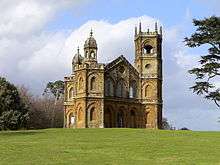
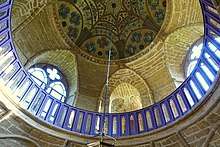
- The Gothic Temple[58] designed by James Gibbs in 1741 and completed about 1748, this is the only building in the Gardens built from ironstone, all the others use a creamy-yellow limestone. The building is triangular in plan of two storeys with a pentagonal shaped tower at each corner, one of which rises two floors higher than the main building, while the other two towers have lanterns on their roofs. Above the door is a quote from Pierre Corneille's play Horace: Je rends grace aux Dieux de n'estre pas Roman (I thank the gods I am not a Roman). The interior includes a circular room of two storeys covered by a shallow dome that is painted to mimic mosaic work including shields representing the Heptarchy. Dedicated 'To the Liberty of our Ancestors'. To quote John Martin Robinson: 'to the Whigs, Saxon and Gothic were interchangeably associated with freedom and ancient English liberties: trial by jury (erroneously thought to have been founded by King Alfred at a moot on Salisbury Plain), Magna Carta, parliamentary representation, all the things which the Civil War and Glorious Revolution had protected from the wiles of Stuart would-be absolutism, and to the preservation of which Lord Cobham and his 'Patriots' were seriously devoted.'[59] The Temple was used in the 1930s by the school as the Officer Training Corps armoury. It is now available as a holiday let through the Landmark Trust.
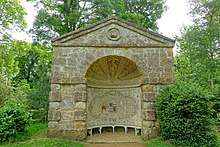
- The Pebble Alcove[60] built of stone before 1739 probably to the designs of Kent. It takes the form of an exedra enclosed by a stone work surmounted by a pediment. The exedra is decorated with coloured pebbles, including the family coat of arms below which is the Temple family motto TEMPLA QUAM DELECTA (How Beautiful are thy Temples).

- The Chatham Urn[61] this is a copy of the large stone urn known as the Chatham Vase carved in 1780 by John Bacon. It was placed in 1831 on a small island in the Octagon Lake. It is a memorial to William Pitt, 1st Earl of Chatham former Prime Minister, who was a relative of the Temple family. The original was sold in 1848 and is now at Chevening House.
.jpg)
- Congreve's Monument[61] of stone designed by Kent in 1736, this is a memorial to William Congreve. It is in the form of a pyramid with an urn carved on one side with Apollo's head, pan pipes and masks of comedy and tragedy; the truncated pyramid supports the sculpture of an ape looking at itself in a mirror, beneath are these inscriptions:
Vitae imitatio Consuetudinis speculum Comoedia |
Comedy is the imitation of life, and the glass of fashion |
Ingenio Acri, faceto, expolito, Moribusque Urabnis |
In the year 1736, COBHAM erected this poor consolation of |

- The Temple of Friendship[62] built of stone in 1739 to the designs of Gibbs. It is located in the south-east corner of the garden. Inscribed on the exterior of the building is AMICITIAE S (sacred to friendship). It was badly damaged by fire in 1840 and remains a ruin. Built as a pavilion to entertain Lord Cobham's friends it was originally decorated with murals by Francesco Sleter including on the ceiling Britannia, the walls having allegorical paintings symbolising friendship, justice and liberty. There was a series of ten white marble busts on black marble pedestals around the walls of Cobham (this bust with that of Lord Westmoreland is now in the V&A Museum) and his friends: Frederick, Prince of Wales; Philip Stanhope, 4th Earl of Chesterfield; George Lyttelton, 1st Baron Lyttelton; Thomas Fane, 8th Earl of Westmorland; William Pitt, 1st Earl of Chatham; Allen Bathurst, 1st Earl Bathurst; Richard Grenville-Temple, 2nd Earl Temple; Alexander Hume-Campbell, 2nd Earl of Marchmont; John Leveson-Gower, 1st Earl Gower. Dated 1741, three were carved by Peter Scheemakers: Cobham, Prince Frederick & Lord Chesterfield, the rest were carved by Thomas Adye. All the busts were sold in 1848. The building consisted of a square room rising through two floors surmounted by a pyramidal roof with a lantern. The front has a portico of four Tuscan columns supporting a pediment, the sides have arcades of one arch deep by three wide also supporting pediments. The arcades and portico with the wall behind are still standing.
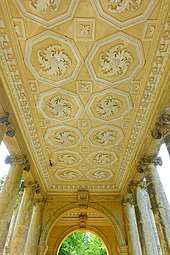
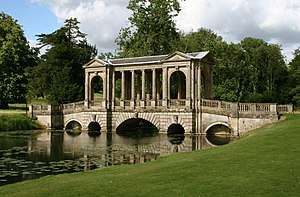
- The Palladian Bridge[63]
This is a copy of the bridge at Wilton House. The main difference is that the Stowe version is designed to be used by horse-drawn carriages so is set lower with shallow ramps instead of steps on the approach. It was completed in 1738 probably under the direction of Gibbs. Of five arches, the central wide and segmental with carved keystone, the two flanking semi-circular also with carved keystones, the two outer segmental. There is a balustraded parapet, the middle three arches also supporting an open pavilion. Above the central arch this consists of colonnades of four full and two half columns of unfluted Roman Ionic order. Above the flanking arches there are pavilions with arches on all four sides. These have engaged columns on their flanks and ends of the same order as the colonnade which in turn support pediments. The roof is of slate, with an elaborate plaster ceiling. It originally crossed a stream that emptied from the Octagon Lake, and when the lake was enlarged and deepened, made more natural in shape in 1752, this part of the stream became a branch of the lake.
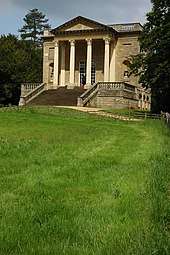
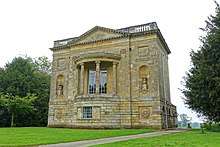
- The Queen's Temple[64] originally designed by Gibbs in 1742 and was then called the Lady's Temple. This was designed for Lady Cobham to entertain her friends. But the building was extensively remodelled in 1772–1774 to give it a neo-classical form. The architect was probably Thomas Pitt, the portico is based on the Maison Carrée. Further alterations were made in 1790 by Vincenzo Valdrè to commemorate George III recovering from madness with the help of Queen Charlotte after whom the building was renamed. The main floor is raised up on a podium, the main facade consists of a portico of four fluted Composite columns, these are approached by a balustraded flight of steps the width of the portico. The facade is wider than the portico, the flanking walls having niches containing ornamental urns. The large door is fully glazed. The room within is the most elaborately decorated of any of the Garden's buildings. The Scagliola Corinthian columns and pilasters are based on the Temple of Venus and Roma, the barrel-vaulted ceiling is coffered. There are several plaster medallions around the walls, Britannia Deject, with this inscription Desideriis icta fidelibus Quaerit Patria Caesarem (For Caesar's life, with anxious hopes and fears Britannia lifts to Heaven a nation's tears), Britannia with a palm branch sacrificing to Aesculapius with this inscription O Sol pulcher! O laudande, Canam recepto Caesare felix (Oh happy days! with rapture Britons sing the day when Heavenrestore their favourite King!) and Britannia supporting a medallion of the Queen with the inscription Charlottae Sophiae Augustae, Pietate erga Regem, erga Rempublicam Virtute et constantia, In difficillimis temporibus spectatissimae D.D.D. Georgius M. de Buckingham MDCCLXXXIX. (To the Queen, Most respectable in the most difficult moments, for her attachment and zeal for the public service, George Marquess of Buckingham dedicates this monument). Other plaster decoration on the walls are 1. Trophies of Religion, Justice and Mercy, 2. Agriculture and Manufacture, 3. Navigation and Commerce and 4. War. Almost all the decoration was the work of Charles Peart except for the statue of Britannia by Joseph Ceracchi. In 1842 the 2nd Duke of Buckingham inserted in the centre of the floor the Roman mosaic found at nearby Foscott. The Temple has been used for over 40 years by the School as its Music School.
- The Saxon Deities[65] these are sculptures by John Michael Rysbrack of the seven deities that gave their names to the days of the week. Carved from Portland stone in 1727. They were moved to their present location in 1773, (the sculptures are copies of the originals that were sold in 1921–1922). They are arranged in a circle. Each sculpture (with the exception of Sunna a half length sculpture) is life size, the base of each statue has a Runic inscription of the god's name, and stands on a plinth. They are: Sunna (Sunday), Mona (Monday), Tiw (Tuesday), Woden (Wednesday), Thuner (Thursday), Friga (Friday) and a Saxon version of Seatern (Saturday), the original Sunna & Thuner statues are in the V&A Museum, the original Friga stood for many years in Portmeirion but was sold at auction in 1994 for £54,000, the original Mona is in the Buckinghamshire County Museum.
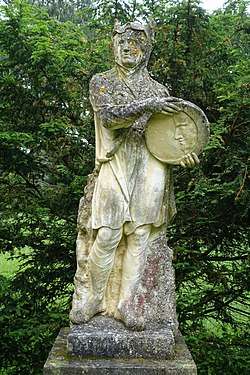 Mona
Mona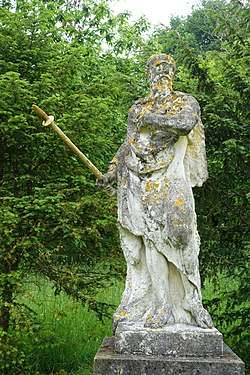 Tiw
Tiw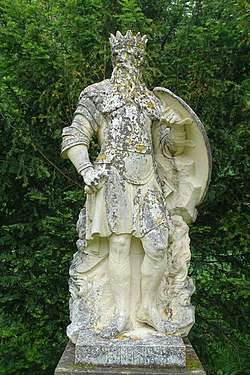 Woden
Woden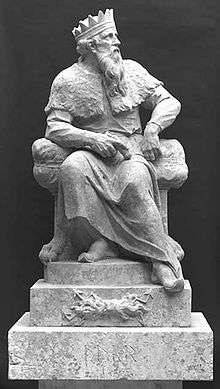 The original Thuner, now in the V&A Museum
The original Thuner, now in the V&A Museum Friga
Friga Seatern
Seatern Sunna
Sunna
The Grecian valley

Is to the north of the Eastern Garden. Designed by Capability Brown and created from 1747 to 1749, this is Brown's first known landscape design. An L-shaped area of lawns covering about 60 acres (24 ha), was formed by excavating 23,500 cubic yards (18,000 m3) of earth by hand and removed in wheelbarrows with the original intention of creating a lake. Mature Lime and Elm trees were transplanted from elsewhere on the estate to create a mature landscape. Other tree species that Brown used in this and other areas of the gardens include: Cedar, Yew, Beech, Sycamore, Larch & Scots Pine. The buildings in this area are:
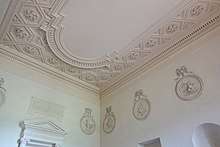
- Temple of Concord and Victory[66]
The designer of this the largest of the garden buildings is unknown, both Earl Temple and Thomas Pitt, 1st Baron Camelford have been suggested as the architect. Built from stone, between 1747 and 1749, the building is located where the two legs of the valley meet. It is raised on a podium with a flight of steps up to the main entrance, the cella and pronaos is surrounded by a peristyle of 28 fluted Roman Ionic columns, ten on the flanks and six at each end. The main pediment contains a sculpture by Peter Scheemakers of Four-Quarters of the World bringing their Various Products to Britannia, there are six statues acroterion of cast lead painted to resemble stone on both the east and west pediments. In the frieze of the entablature are the words CONCORDIAE ET VICTORIAE, the sculpture on the building dates from the 1760s when it was converted into a monument to the British victory in the Seven Years' War. The ceiling of the peristyle is based on an engraving by Robert Wood of a ceiling in Palmyra. Within the pronaos and cella are 16 terracotta medallions commemorating British Victories in the Seven Years' War, these were designed by James "Athenian" Stuart, each one is inscribed with the name of the battle: Quebec; Martinico & c.; Louisbourg; Guadeloupe & c.; Montreal; Pondicherry & c.; the naval battle of Belleisle; the naval battle of Lagos; Crevelt & Minden; Fellinghausen; Goree and Senegal; Crown Point, Niagara and Quesne; Havannah and Manila; Beau Sejour, Cherburgh and Belleisle. The wooden doors are painted a Prussian blue with gilded highlights on the moldings. Above the door is an inscription by Valerius Maximus:
Quo Tempore Salus eorum in ultimas Ausustias deducta |
The Times with such alarming Dangers fraught |
The interior end wall of the cella has an aedicule containing a statue of Liberty. Above is this inscription:
Candidis autem animis voluptatem praebuerint in |
A sweet sensation touches every breast of candour's generous sentiment possest, |
When the School built its Chapel in the late 1920s, 16 of the 28 columns from this Temple were moved to the new building, being replaced with plain brickwork. One of the earliest National Trust restoration works was to create replacement columns with which to restore the Temple.
.jpg)
- The Fane of Pastoral Poetry,[67] located in a grove of trees at the eastern end of the Grecian Valley at the north-east corner of the gardens, it is a small belvedere designed by James Gibbs in 1729 it was moved to its present position in the 1760s. It is square in plan with chamfered corners that, built of stone, each side is an open arch, Herma protrude from each chamfered corner. It is surmounted by an octagonal lead dome.
.jpg)
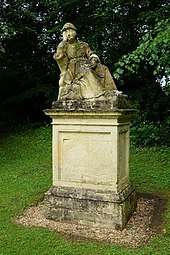
- The Circle of the Dancing Faun Located near the north-east end of the valley near the Fane of Pastoral Poetry, the Dancing Faun commanded the centre of a circle of five sculptures of shepherds and shepherdesses, all of the sculptures had been sold. Two of these statues were located in Buckingham and restored in 2009 to their original place in the garden. In 2016 the Faun supported by the so-called Saxon Altar and the other three statues where recreated.
.jpg)
.jpg)
- The Cobham Monument,[67] to the south of the Grecian Valley is the tallest structure in the gardens rising 104 feet (32 m). Built 1747–49 of stone, probably designed by Brown. It consists of a square plinth with corner buttresses surmounted by Coade stone lions holding shields added in 1778. The column itself is octagonal with a single flute on each face, with a molded doric capital and base. On which is a small belvedere of eight arches with a dome supporting the sculpture of Lord Cobham, the probable sculptor of which was Peter Scheemakers, the current statue is a recreation of 2001 after the original was struck by lightning in 1957. A spiral staircase rises through the column to the belevedere providing an elevated view of the gardens. Lord Cobham's Walk is a tree-lined avenue that stretches from the Pillar north-east to the edge of the gardens.
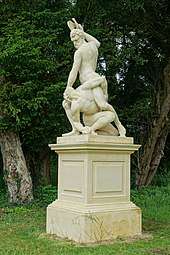

- Statues surrounding the Grecian Valley The National Trust is creating copies of the statues that used to be found around the edge of the Grecian Valley and is adding them as and when funds can be raised to cover the cost. The sculptures included Samson and the Philistine recreated in 2015, several of the twelve Labours of Hercules so far only Hercules and Antaeus has been recreated in 2016 and a statue of a gladiator in 2017. In 2018 a replacement of the statue of Thalia holding a scroll with the words 'Pastorum Carmina Canto' on it was erected near the Fane of Pastoral Poetry, the statue is based on a work by John Nost. In 2019 a copy of the Grecian Urn sold in 1921 and now at Trent Park has been erected near the Circle of the Dancing Faun.
The western garden
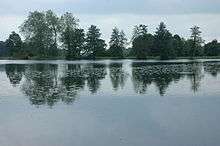
Is to the immediate west of the South Vista, including the Eleven-Acre Lake. This area of the gardens was developed from 1712 to 1770s when it underwent its final landscaping. The Eleven-acre lake was extended and given a natural shape in 1752. In the woods to the north-west in 2017 the National Trust recreated the lost sculpture of the Wrestlers in 2018 the paths surrounding the sculpture were recreated and the Labyrinth around them replanted with 3,500 shrubs including magnolia, laurel, box, yew, spindle and hazel. Within the labyrinth are an outdoor skittle alley and a rustic swing. Also in this area in the woods to the north of the lake but on the east side is the Sleeping Wood designed by Bridgeman, at the heart of which use to stand the Sleeping Parlour being built in 1725 to a design by Vanbrugh, this was inspired by Charles Perrault's tale of Sleeping Beauty. Pegg's Terrace is a raised avenue of trees that follows the line of the south ha-ha between the Lake Pavilions and the Temple of Venus. Warden Hill Walk, also a raised avenue of trees is on the western edge of the gardens, the southern part of which serves as a dam for the Eleven Acre Lake, links The Temple of Venus to the Boycott Pavilions. The buildings in this area are:


- The Rotondo[68] designed by Vanbrugh and built 1720–1721, this is a circular temple, consisting of ten unfluted Roman Ionic columns raised up on a podium of three steps. The dome was altered by Borra in 1773–1774 to give it a lower profile. In the centre is a statue of Venus raised on a tall decorated plinth. The current sculpture is a recent replacement for the original and is gilt.
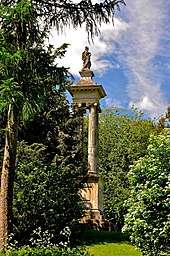
- Statue of Queen Caroline[69] this takes the form of a Tetrapylon, a high square plinth surmounted by four fluted Roman Ionic columns supporting an entablature which in turn supports the statue of Queen Caroline on its pedestal around which is inscribed Honori, Laudi, Virtuti Divae Carolinae (To honour, Praise and Virtue of the Divine Caroline). Probably designed by Vanbrugh.
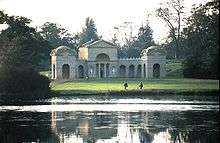
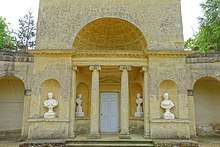
- The Temple of Venus[70] dated 1731 this was the first building in the gardens designed by William Kent. Located in the south-west corner of the gardens on the far side of the eleven-acre lake. The stone building takes the form of one of Palladio's villas, the central rectangular room linked by two quadrant arcades to pavilions. The main pedimented facade has an exedra screened by two full and two half Roman Ionic columns, there are two niches containing busts either side of the door of Cleopatra & Faustina, the exedra is flanked by two niches containing busts of Nero and Vespasian all people known for their sexual appetites. The end pavilions have domes. Above the door is carved VENERI HORTENSI "to Venus of the garden". The interior according to the 1756 Seeley Guidebook was decorated with murals painted by Francesco Sleter the centre of the ceiling had a painting of a naked Venus and the smaller Compartments were painted with a variety of intrigues. The walls had paintings with scenes from Spenser's The Faerie Queene. The paintings were destroyed in the late 18th century. Reverend John Wesley, who visited in 1779, said the paintings were "lewd". The ceiling frieze had this inscription by Catullus:
Nunc amet qui nondum amavit: |
Let him love now, who never lov'd before: |
- The Hermitage[71] designed c1731 by Kent, heavily rusticated and with a pediment containing a carving of panpipes within a wreath, and a small tower to the right of the entrance.
.jpg)
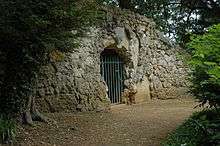
- Dido's Cave[72] is little more than an alcove, probably built in the 1720s, originally decorated with a painting of Dido and Aeneas. In c.1781 the facade was decorated with tufa by the Marchioness of Buckingham. Her son the 1st Duke of Buckingham turned it into her memorial by adding the inscription Mater Amata, Vale! (Farewell beloved Mother). The designer is unknown.
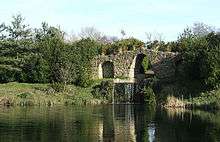
- The Artificial Ruins & The Cascade[73] constructed in the 1730s the cascade links the Eleven Acre Lake which is higher with the Octagon Lake. The ruins are a series of arches above the cascade built to look ruinous.
- The Menagerie[74] of stone built c1781 probably to the designs of Valdrè. Hidden in the woods to the west of the south vista. It was built by the Marquess of Buckingham for his wife as a retreat. The 1st Duke converted it to display stuffed animals, including a 32 feet (9.8 m) long Boa constrictor and 10,000 geological specimens that he acquired in 1819 at the sale of William Bullock's collection, these were all sold in the 1848 sale. The central room is surmounted by a dome that has an exterior clad in copper, the interior of the dome is decorated with a painting by Vincenzo Valdrè of a pergola with vines. The facade consists of four evenly spaces Ionic pilasters the centre pair flanking the arched entrance doors, the outer pair niches. There are two quadrant wings of five bays flanked by Ionic columns matching the pilasters, between which are windows the rooms behind being orangeries the ends of which are solid walls with arched doors in the middle flanked by herms, the whole surmounted by pediments. There used to be a formal rectangular flower garden in front of the building, but it is now covered by tennis courts.
The Lamport Gardens
_-_Buckinghamshire%2C_England_-_DSC06720.jpg)
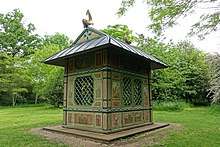
Lying to the east of the Eastern Gardens, this was the last and smallest area just 17 acres (6.9 ha) added to the gardens. Named after the vanished hamlet of Lamport, the gardens were created from 1826 by Richard Temple-Grenville, 1st Duke of Buckingham and Chandos and his gardener James Brown, from 1840 2nd Duke of Buckingham's gardener Mr Ferguson and the architect Edward Blore adapted it as an ornamental rock and water garden. Originally the garden was stocked with exotic birds including Emus. The whole garden is surrounded by wire fencing to keep out Foxes. The buildings in this area are:
- The Chinese House[75] is known to date from 1738 making it the first known building in England built in the Chinese style. It is made of wood and painted on canvas inside and out by Francesco Sleter. Originally it was on stilts in a pond near the Elysian Fields. In 1750 it was moved from Stowe and was purchased by the National Trust in 1996 and returned and placed in its present position. The Chinoiserie Garden Pavilion at Hamilton Gardens in New Zealand is based on the Chinese House.[76]
- The Lamport Lodge this uniquely for the gardens red brick lodge, in a Tudor Gothic style, with two bay windows either side of porch and is a remodelling of 1840–1841 by Blore of an earlier building. It acts as an entrance through the ha-ha. There are three sets of iron gates, that consists of one carriage and two flanking pedestrian entrances. They lead to an avenue of Beech trees planted in 1941 that lead to the Gothic Temple.
Demolished buildings and monuments
As the design of the Gardens evolved many changes were made. This resulted in the demolition of many monuments. The following is a list by area of such monuments.
The Approaches
- The Chackmore Fountain Built c.1831, situated halfway down the Grand Avenue near the hamlet of Chackmore, dismantled in the 1950s.
The forecourt
- Nelson's Seat situated a few yards to the north-west house, built in 1719–1720 to the design of Vanbrugh. It was named after William Nelson the foreman in-charge of building it, remodelled in 1773 with a Doric portico and demolished before 1797 the site is marked by a grass mound.
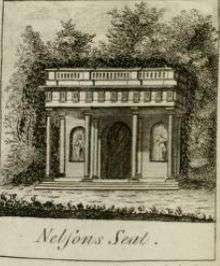
The western garden
- The Queen's Theatre created in 1721, stretching from the Rotondo to the south vista this consisted of a formal canal basin and elaborate grass terracing, this was re-landscaped in 1762–1764 to match the naturalistic form of the gardens as a whole.
- The Vanbrugh pyramid was situated in the north-western corner of the garden. Erected in 1726 to Vanbrugh's design, it was 60 feet (18 m) in height of steeply stepped form. It was demolished in 1797 and only the foundations survive. The pyramid carried this inscription by Gilbert West:
Lamented Vanbrugh! This thy last Design,
Among the various Structures, that around,
Form'd by thy Hand, adorn this happy Ground,
This, sacred to thy Memory shall stand:
Cobham, and grateful Friendship so command.
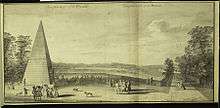
- St. Augustine's Cave A rustic edifice with a thatched roof, built in the 1740s it had disappeared by 1797.
- The Temple of Bacchus designed by Vanbrugh and built c.1718, to the west of the house, originally of brick it was later covered in stucco and further embellished with two lead sphinxes. It was demolished in 1926 to make way for the large school chapel designed by Sir Robert Lorimer.
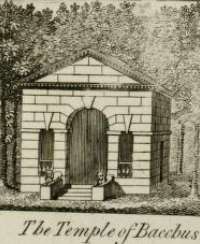
- Coucher's Obelisk a dwarf obelisk erected before 1725, which was subsequently moved at least twice to other locations in the garden until its removal c.1763. It commemorated Reverend Robert Coucher, chaplain to Lord Cobham's dragoons.
- The Queen of Hanover's Seat in a clearing south-west of the site of the temple of Bacchus. Originally called the Saxon altar it was the focus of the circle of Saxon Deities in 1727, it was moved in 1744 to the Grecian Valley to serve as a base of a statue of a 'Dancing Faun' until being moved to this location in 1843 and inscribed to commemorate a visit by the Queen of Hanover in that year. Sold in 1921 it is now in a garden in Yorkshire.
- Cowper's Urn A large stone urn surrounded by a wooden seat, erected in 1827 just to the west of the Hermitage, sold in 1921 its current location is unknown.
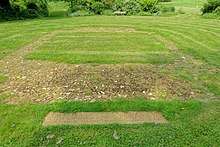
- The Sleeping Parlour probably designed by Vanbrugh, erected in 1725 in the woods next to the South Vista, it was square with Ionic porticoes on two sides one inscribed 'Omnia sint in incerto, fave tibi' (Since all things are uncertain, indulge thyself). It was demolished in 1760.
- The Cold Bath built around 1723 to Vanbrugh's design, it was a simple brick structure located near the Cascade. Demolished by 1761.
The Elysian fields
- The Temple of Modern Virtue to the south of the Temple of Ancient Virtue, built in 1737, it was built as an ironic classical ruin, with a headless statue in contemporary dress. It appears that it was left to fall down, there are slight remnants in the undergrowth.
- The Gosfield Altar erected on an island in the lake, this was an Antique classical altar erected by Louis XVIII of France in gratitude for being allowed to use Gosfield Hall in Essex. It was moved from there by the 1st Duke in 1825, it had disappeared by 1843.
- The Temple of Contemplation Now replaced by the Four Seasons Fountain. It was in existence by 1750 and had a simple arcaded front with pediment. It was later used as a cold bath until replaced by the fountain.
- The Witch House built by 1738 it was in a clearing behind the Temple of Ancient Virtue, built of brick with sloping walls and a heavy, over-sailing roof, the interior had a mural painting of a witch. The date it was demolished is unknown.
- Apollo and the Nine Muses arranged in a semicircle near the Doric Arch there used to be statues of Apollo and the Nine Muses removed sometime after 1790. These sculptures were created by John Nost and were originally positioned along the south vista in 1682.
- The 1st Duchess's Urn near the Gothic Cross; it was of white marble, erected by the 2nd Duke to commemorate his mother.
The Eastern Garden
- The Imperial Closet this small building was situated to the east of the Temple of Friendship designed by Gibbs and built in 1739. The interior had paintings of Titus, Hadrian and Marcus Aurelius with these inscriptions beneath each painting: Diem perdidi ("I have lost the day"); Pro me: si merear in me ("For me, but if I deserve it, against me"); and Ita regnes imperator, ut privatus regi te velis ("So govern when an emperor, as, if a private person, you would desire to be governed"). The building was demolished in 1759.
- The 1st Duke's Urn erected in 1841 by the 2nd Duke to commemorate his father. It stood by the path to the Lamport Gardens. It was removed in 1931 to the school.
The Grecian Valley
- Sculpture The valley used to have several lead sculptures placed at strategic points around it, including 'Hercules and Antaeus', 'Cain and Abel', 'Hercules and the Boar', 'The Athlete' and 'The Dancing Faun'.
Several of the sculptures have ended up at Trent Park, purchased by Philip Sassoon in 1921, these are:
- 'Time and Opportunity', or 'Peace Embracing Time'
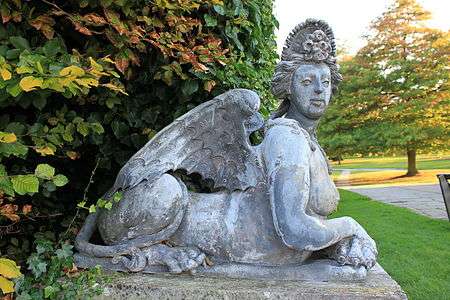 A Sphinx
A Sphinx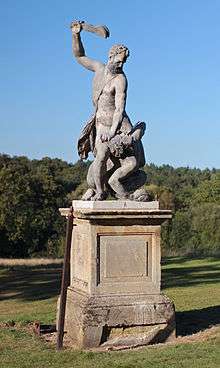 Samson defeating a Philistine
Samson defeating a Philistine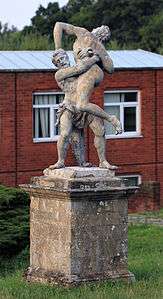 Hercules and Antaeus
Hercules and Antaeus
The park

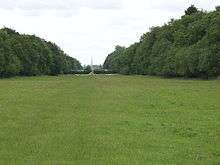
Surrounding the Gardens it originally covered over 5,000 acres (2,000 ha) and stretched north into the adjoining county of Northamptonshire. There is a cascade of 25 feet (7.6 m) high leading out of the Eleven Acre Lake by a tunnel under the Warden Hill Walk on the western edge of the garden, into the Copper Bottom lake that was created in the 1830s just to the south-west of the gardens. The lake was originally lined with copper to waterproof the porous chalk into which the lake was dug. The copper was replaced by butyl sheeting when the Trust restored the lake. The rivers and lakes of both the park and gardens have many species of fish including: carp, perch, pike, roach, rudd & tench. The house's kitchen garden, extensively rebuilt by the 2nd Duke, was located at Dadford about 2/3 of mile north of the house. Only a few remains of the three walled gardens now exist, but originally they were divided into four and centred around fountains. There is evidence of the heating system: cast iron pipes used to heat greenhouses, which protected the fruit and vegetables, including then-exotic fruits, like peaches. About a mile and half north of the house lies Haymanger pond, which is a haven for wildlife and attracts grebes, snipe, buzzards and grass snakes, as well as other species. In what used to be the extreme north-east corner of the park, about 2.5 miles (4.0 km) from the house over the county border lies Silverstone Circuit. This corner of the park used to be heavily wooded, known as Stowe Woods, with a series of avenues cut through the trees, over a mile of one of these avenues (or riding) still survives terminated in the north by the racing circuit and aligned to the south on the Wolfe Obelisk though there is a gap of over half-mile between the two. It is here that one can find the remains of the gardener's treehouse, an innovative design comprising wood and textiles. The National Trust have reintroduced Longhorn cattle to graze the park north of the house.
The school had given the National Trust a protective covenant over the gardens in 1967, but the first part they actually acquired was the 28 acres (11 ha) of the Oxford Avenue in 1985, purchased from the great-great-grandson of the 3rd Duke, Robert Richard Grenville Close-Smith, a local landowner. The National Trust has pursued a policy of acquiring more of the original estate, only a fraction of which was owned by the school, in 1989 the school donated 560 acres (230 ha) including the gardens. In 1992 some 58 acres (23 ha) of Stowe Castle Farm located to the east of the gardens was purchased and in 1994 part of New Inn Farm to the south of the gardens was bought. Then 320 acres (130 ha) of Home Farm to the north and most of the 360-acre (150 ha) fallow deer-park to the south-west of the gardens were acquired in 1995, this was restored in 2003 there are now around 500 deer in the park. In 2005 a further 9.5 acres (3.8 ha) of New Inn Farm including the Inn itself were acquired. The Trust now owns 750 acres (300 ha) of the original park. In the mid-1990s the National Trust replanted the double avenue of trees that surrounded the ha-ha to the south and south-west including the two bastions that project into the park on which sit the temples of Friendship at the south-east corner and Venus at the south-west corner, connecting with the Oxford Avenue by the Boycott Pavilions, the Oxford Avenue then continues to the north-east following the ha-ha and ends level with the Fane of Pastoral Poetry at the north-east corner of the gardens.
The buildings in the Park include:
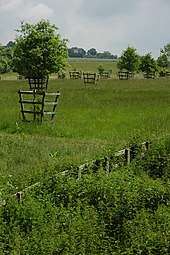
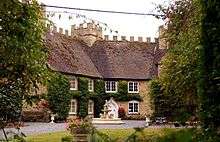
- Stowe Castle (Not owned by the National Trust) is two miles (3 km) to the east of the gardens, built in the 1730s probably to designs by Gibbs. The tall curtain wall visible from the gardens actually disguises several farmworkers' cottages.
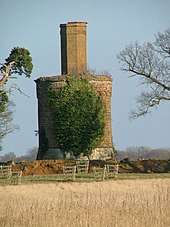
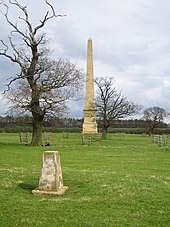
- The Bourbon Tower about a thousand feet to the east of the Lamport garden, was built c1741 probably to designs by Gibbs, it is a circular tower of three floors with a conical roof, it was given its present name in 1808 to commemorate a visit by the exiled French royal family.
- The 2nd Duke's Obelisk near the Bourbon Tower, this granite obelisk was erected in 1864.
- The Wolfe Obelisk stone 100 feet (30 m) high located about 2,000 feet (610 m) to the north-west of the garden, originally designed by Vanbrugh, it was moved in 1754 from the centre of the Octagon Lake and is a memorial to General Wolfe.
- The Gothic Umbrello also called the Conduit House it houses beneath its floor a conduit. about a 1,000 feet (300 m) south of the Wolfe Obelisk, is a small octagonal pavilion dating from the 1790s. The coat of arms of the Marquess of Buckingham, dated 1793, made from Coade stone are place over the entrance door.
- Silverstone Lodges (Not owned by the National Trust), built by the 1st Duke, these twin lodges used to flank the northern entrance to the park, and used to lead to the private carriage drive from Silverstone to the house. The drive no longer exists, this having long since been destroyed, part of it passed through what is now the racing circuit.
Listed status
Stowe has one of the largest concentrations of Grade I listed buildings in England. There are Grade I listings in place for 27 separate structures. These account for nearly 0.5% of the approximately 9,000 grade I listings in England and Wales. The other historic buildings in the garden and park are listed grade II* or grade II.[77] The extensive parks and gardens are listed Grade I on the Register of Historic Parks and Gardens.[78]
| Grade I listed buildings at Stowe House |
|---|
| The following discussion has been closed. Please do not modify it. |
|
Stowe on film
- The North Front doubled as Berlin in the Steven Spielberg 1989 film Indiana Jones and the Last Crusade. The scene was filmed at night and depicted a Nazi book burning.
- The television series Inspector Morse used the gardens in the 1989 episode "Ghost in the Machine" to represent the grounds of 'Hanbury Hall'.
- The 1998 television series Vanity Fair used the gardens to represent London's Hyde Park.
- The Gothic Temple appears (portraying a Scottish church) in the 1999 James Bond film The World Is Not Enough.
- The 2001 Bollywood film Kabhi Khushi Kabhie Gham used the house as a location.
- The opening scene of 2007 film Stardust was shot in the Marble Saloon; the gardens were also used.
- In 2010, the funeral of Talbot's brother in The Wolfman was filmed in the gardens.
- In 2011 X-Men: First Class used the Music Room as a location.
- In 2012 the Antiques Roadshow visited Stowe.
- In 2014 Lucy Worsley presented on the BBC the three-part series The First Georgians: The German Kings Who Made Britain. The second episode featured Stowe Gardens.
- In 2015 Bill used the interior and south portico as locations
- In 2017 series 2 of the TV series The Crown filmed in several of the main rooms
The house and gardens have also featured in documentary films:
- In 2006 Simon Thurley's Buildings That Shaped Britain: The Country House.
- In 2007 Jonathan Meades's Abroad Again, in the episode "Stowe Gardens".
Notes
- Historic England. "STOWE SCHOOL – The Mansion with attached service ranges (now Nugent House, Cobham House and Grafton House) (formerly listed as Stowe House) (Grade I) (1311507)". National Heritage List for England. Retrieved 12 April 2019.
- page 134, Temples of Delight: Stowe Landscape Gardens by John Martin Robinson, 1999, George Philip Publishers
- Adams & Adams 1851, p. 394.
- UK Retail Price Index inflation figures are based on data from Clark, Gregory (2017). "The Annual RPI and Average Earnings for Britain, 1209 to Present (New Series)". MeasuringWorth. Retrieved 2 February 2020.
- page 60, Stowe Landscape Gardens, James Shurmer, 1997 National Trust
- page 68, Stowe Landscape Gardens, James Shurmer, 1997 National Trust
- "Grenville, Anna Eliza Temple-Nugent-Brydges-Chandos-, duchess of Buckingham and Chandos (1779–1836), plantation and slave owner | Oxford Dictionary of National Biography". www.oxforddnb.com. doi:10.1093/ref:odnb/109598. Retrieved 19 March 2019.
- page 81, Stowe Landscape Gardens, James Shurmer, 1997 National Trust
- London's Mansions The Palatial Houses of the Nobility, p144, by David Pearce, Batsford 1986
- pages 82, Stowe Landscape Gardens, James Shurmer, 1997 National Trust
- page 82, Stowe Landscape Gardens, James Shurmer, 1997 National Trust
- pages 11–13, Stowe House, Michael Bevington, 2002, Paul Holberton Publishing
- The Times, "The health of the Duke of Wellington", 26 April 1824
- The Morning Post, "SALE OF THE STOWE LIBRARY", 20 January 1849
- pages 39–42, Stowe House, Michael Bevington, 2002, Paul Holberton Publishing
- pages 36–38, Stowe House, Michael Bevington, 2002, Paul Holberton Publishing
- pages 51–55, Stowe House, Michael Bevington, 2002, Paul Holberton Publishing
- pages 48–51, Stowe House, Michael Bevington, 2002, Paul Holberton Publishing
- pages 54–57, Stowe House, Michael Bevington, 2002, Paul Holberton Publishing
- pages 57–59, Stowe House, Michael Bevington, 2002, Paul Holberton Publishing
- pages 60–61, Stowe House, Michael Bevington, 2002, Paul Holberton Publishing
- pages 62–65, Stowe House, Michael Bevington, 2002, Paul Holberton Publishing
- pages 45–48, Stowe House, Michael Bevington, 2002, Paul Holberton Publishing
- pages 31–33, Stowe House, Michael Bevington, 2002, Paul Holberton Publishing
- pages 33–34, Stowe House, Michael Bevington, 2002, Paul Holberton Publishing
- pages 67–68, Stowe House, Michael Bevington, 2002, Paul Holberton Publishing
- pages 78–80, Stowe House, Michael Bevington, 2002, Paul Holberton Publishing
- pages 75–76, Stowe House, Michael Bevington, 2002, Paul Holberton Publishing
- pages 42–43, Stowe House, Michael Bevington, 2002, Paul Holberton Publishing
- pages 43–45, Stowe House, Michael Bevington, 2002, Paul Holberton Publishing
- pages 39 Stowe House, Michael Bevington, 2002, Paul Holberton Publishing
- page 106, Charles Bridgeman and the English Landscape Garden, Peter Willis, 1977, A. Zwemmer Ltd, ISBN 0-302-02777-7
- page 210, Sir John Vanbrugh: Storyteller in Stone, Vaughan Hart, 2008, Yale University Press, ISBN 978-0-300-11929-9
- page 179, James Gibbs, Terry Friedman, 1984, Yale University Press, ISBN 0-300-03172-6
- page 208, William Kent, Architect, designer, Painter, Gardener, 1685–1748, Michael I. Wilson, 1984, Routledge & Kegan Paul, ISBN 0-7100-9983-5
- page 52, Capability Brown, Dorothy Stroud, 1984, Faber and Faber, ISBN 0-571-13405-X
- page 55, Capability Brown, Dorothy Stroud, 1984, Faber and Faber, ISBN 0-571-13405-X
- page 153, Landmark: A History of Britain in 50 Buildings, Anna Keay & Caroline Stanford, 2015, Quitessence Editions Ltd, ISBN 978-0-7112-3645-5
- Page 89, English Gardens and Landscapes 1700–1750, Christopher Hussey, Country Life 1967
- page 111, Temples of Delight: Stowe Landscape Gardens, John Martin Robinson, 1990, George Philips
- page 8, Stowe Landscape Gardens, James Shurmer, 1997 National Trust
- page 9, Stowe Landscape Gardens, James Shurmer, 1997 National Trust
- page 10, Stowe Landscape Gardens, James Shurmer, 1997 National Trust
- page 11, Stowe Landscape Gardens, James Shurmer, 1997 National Trust
- page 10-11, Stowe Landscape Gardens, James Shurmer, 1997 National Trust
- page 12, Stowe Landscape Gardens, James Shurmer, 1997 National Trust
- page 23, Stowe Landscape Gardens, James Shurmer, 1997 National Trust
- page 24, Stowe Landscape Gardens, James Shurmer, 1997 National Trust
- "Person Page". thepeerage.com.
- page 26, Stowe Landscape Gardens, James Shurmer, 1997 National Trust
- pages 28–30, Stowe Landscape Gardens, James Shurmer, 1997 National Trust
- page 31, Stowe Landscape Gardens, James Shurmer, 1997 National Trust
- pages 31–32, Stowe Landscape Gardens, James Shurmer, 1997 National Trust
- page 32, Stowe Landscape Gardens, James Shurmer, 1997 National Trust
- pages 32–33, Stowe Landscape Gardens, James Shurmer, 1997 National Trust
- page 33, Stowe Landscape Gardens, James Shurmer, 1997 National Trust
- pages 36–37, Stowe Landscape Gardens, James Shurmer, 1997 National Trust
- page 102, Temples of Delight: Stowe Landscape Gardens, John Martin Robinson, 1990, George Philips
- page 37, Stowe Landscape Gardens, James Shurmer, 1997 National Trust
- page 38, Stowe Landscape Gardens, James Shurmer, 1997 National Trust
- pages 38–40, Stowe Landscape Gardens, James Shurmer, 1997 National Trust
- pages 40–42, Stowe Landscape Gardens, James Shurmer, 1997 National Trust
- pages 42–43, Stowe Landscape Gardens, James Shurmer, 1997 National Trust
- pages 43–44, Stowe Landscape Gardens, James Shurmer, 1997 National Trust
- Pages 47–50, Stowe Landscape Gardens, James Shurmer, 1997 National Trust
- Page 50, Stowe Landscape Gardens, James Shurmer, 1997 National Trust
- Pages 13–15, Stowe Landscape Gardens, James Shurmer, 1997 National Trust
- Pages 15–16, Stowe Landscape Gardens, James Shurmer, 1997 National Trust
- Pages 16–17, Stowe Landscape Gardens, James Shurmer, 1997 National Trust
- Pages 19–20, Stowe Landscape Gardens, James Shurmer, 1997 National Trust
- Page 19, Stowe Landscape Gardens, James Shurmer, 1997 National Trust
- Pages 20–21, Stowe Landscape Gardens, James Shurmer, 1997 National Trust
- Page 21, Stowe Landscape Gardens, James Shurmer, 1997 National Trust
- Pages 45, Stowe Landscape Gardens, James Shurmer, 1997 National Trust
- "Chinoiserie Garden". hamiltongardens.co.nz. Hamilton Gardens. Retrieved 26 September 2015.
- "English Heritage Images of England: a searchable photographic archive of the historic buildings of England". www.imagesofengland.org.uk. Archived from the original on 28 October 2005.
- Historic England, "Stowe (1000198)", National Heritage List for England, retrieved 5 February 2016
References
- Adams, John; Adams, Charles Francis (1851). The Works of John Adams, Second President of the United States: Autobiography, continued. Diary. Essays and controversial papers of the Revolution. The Works of John Adams, Second President of the United States. 3. Little, Brown. p. 394.CS1 maint: ref=harv (link)
External links
| Wikimedia Commons has media related to Stowe House. |